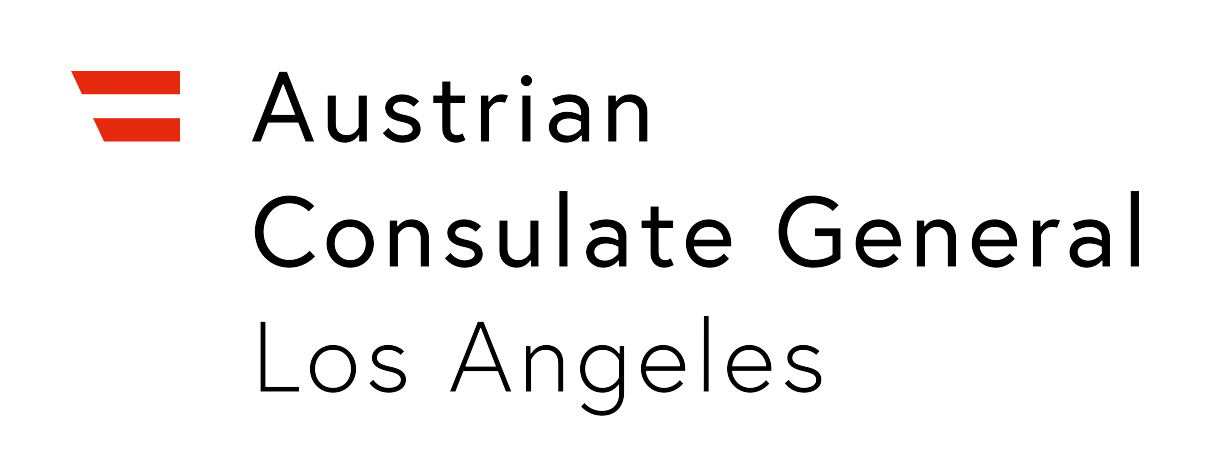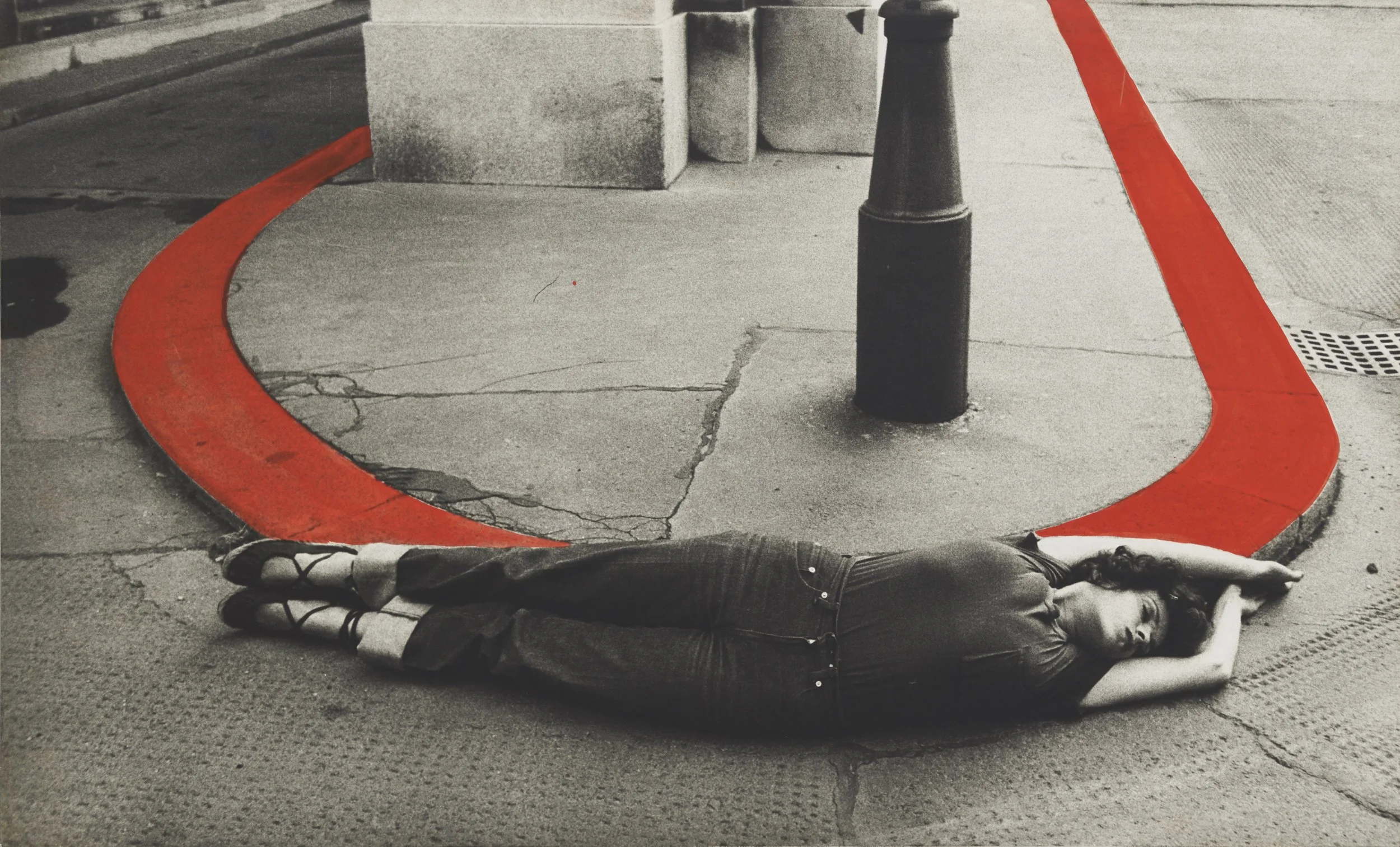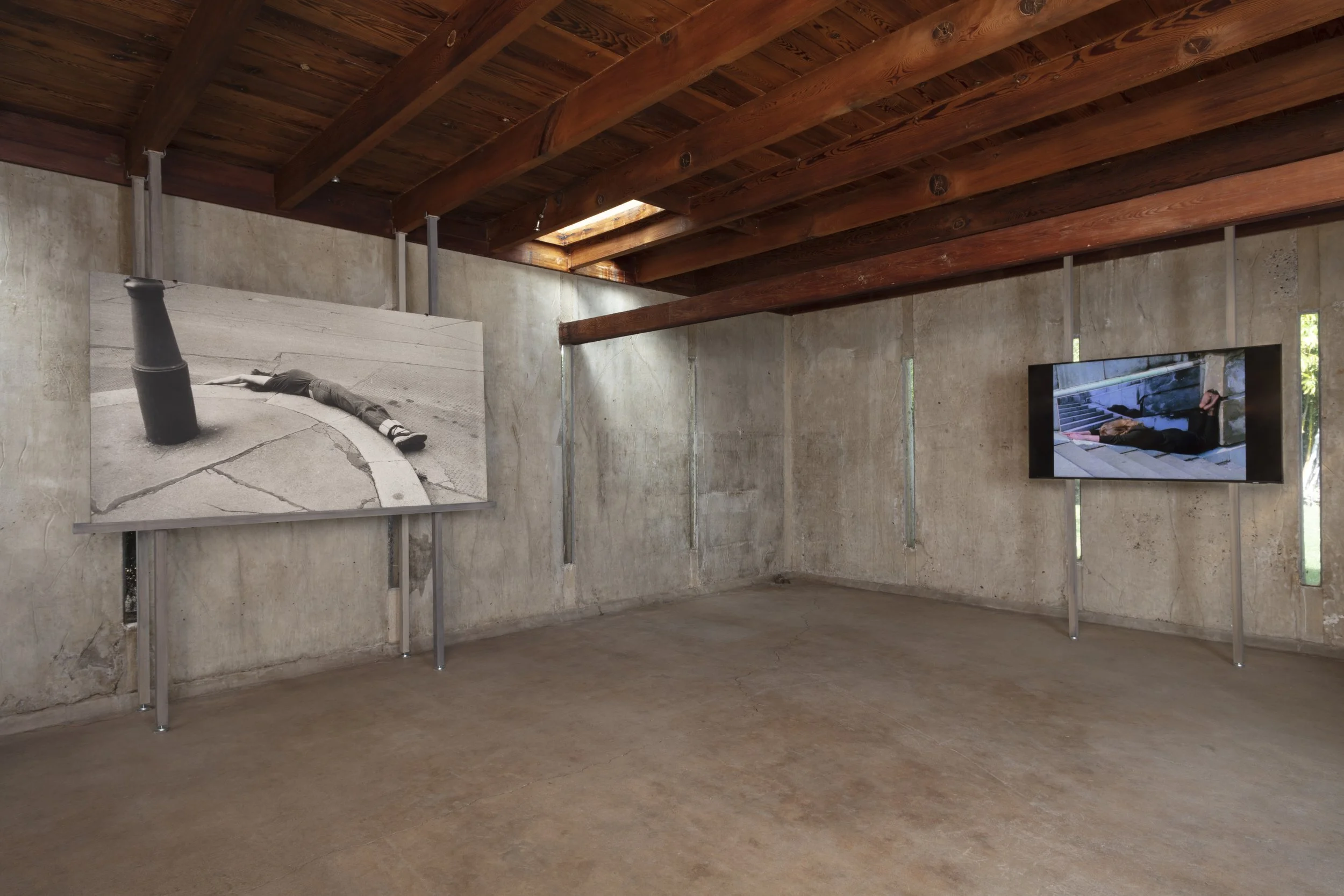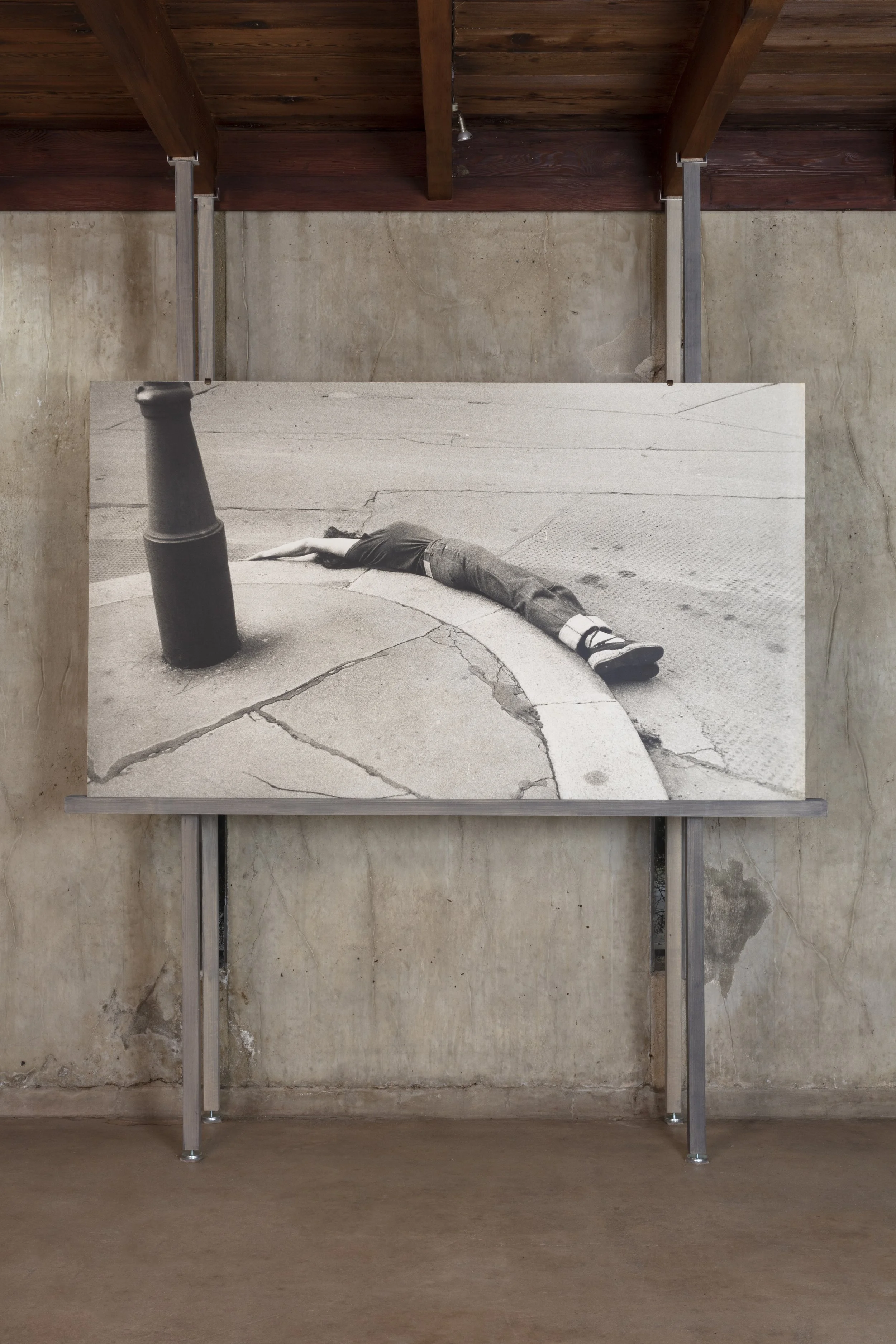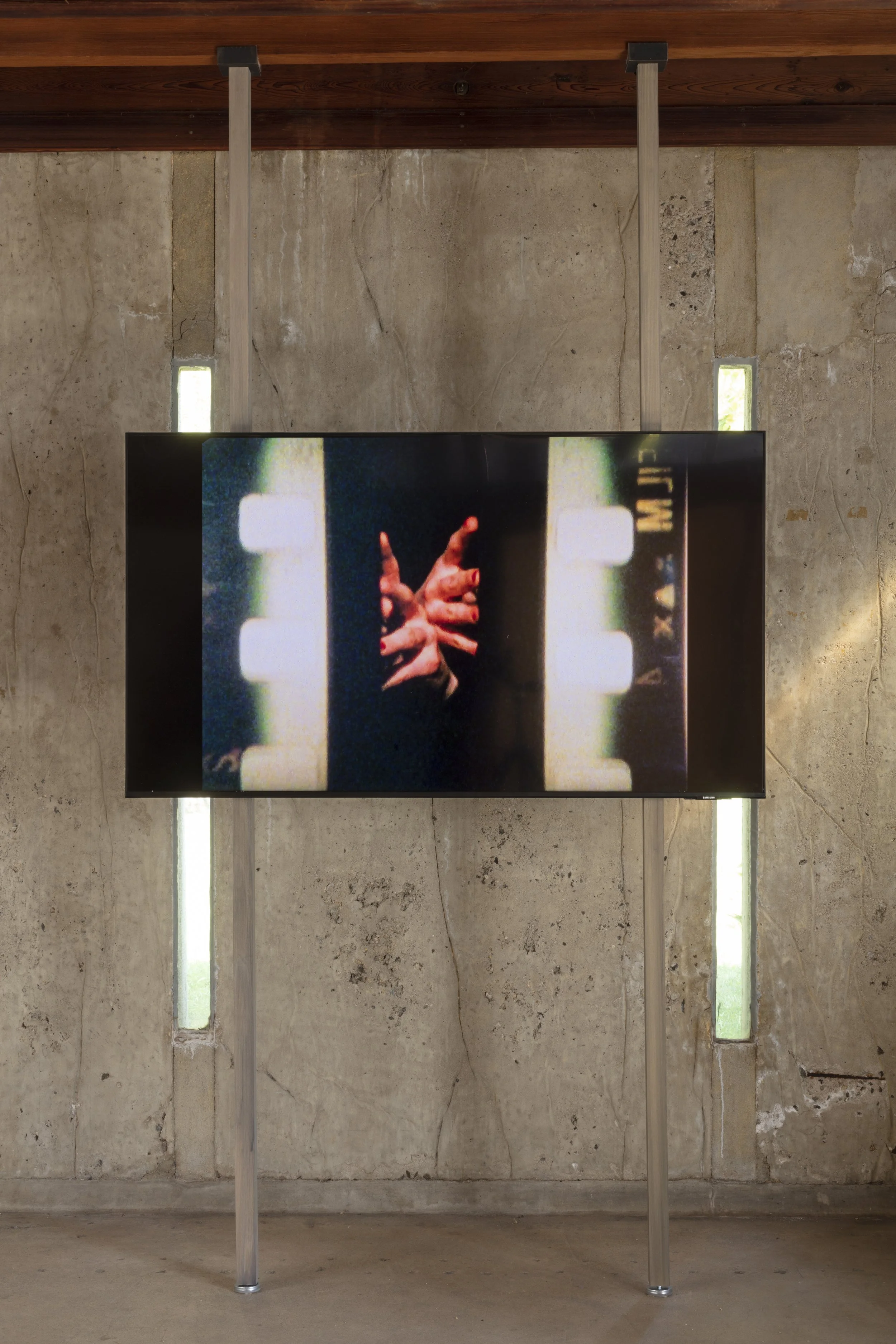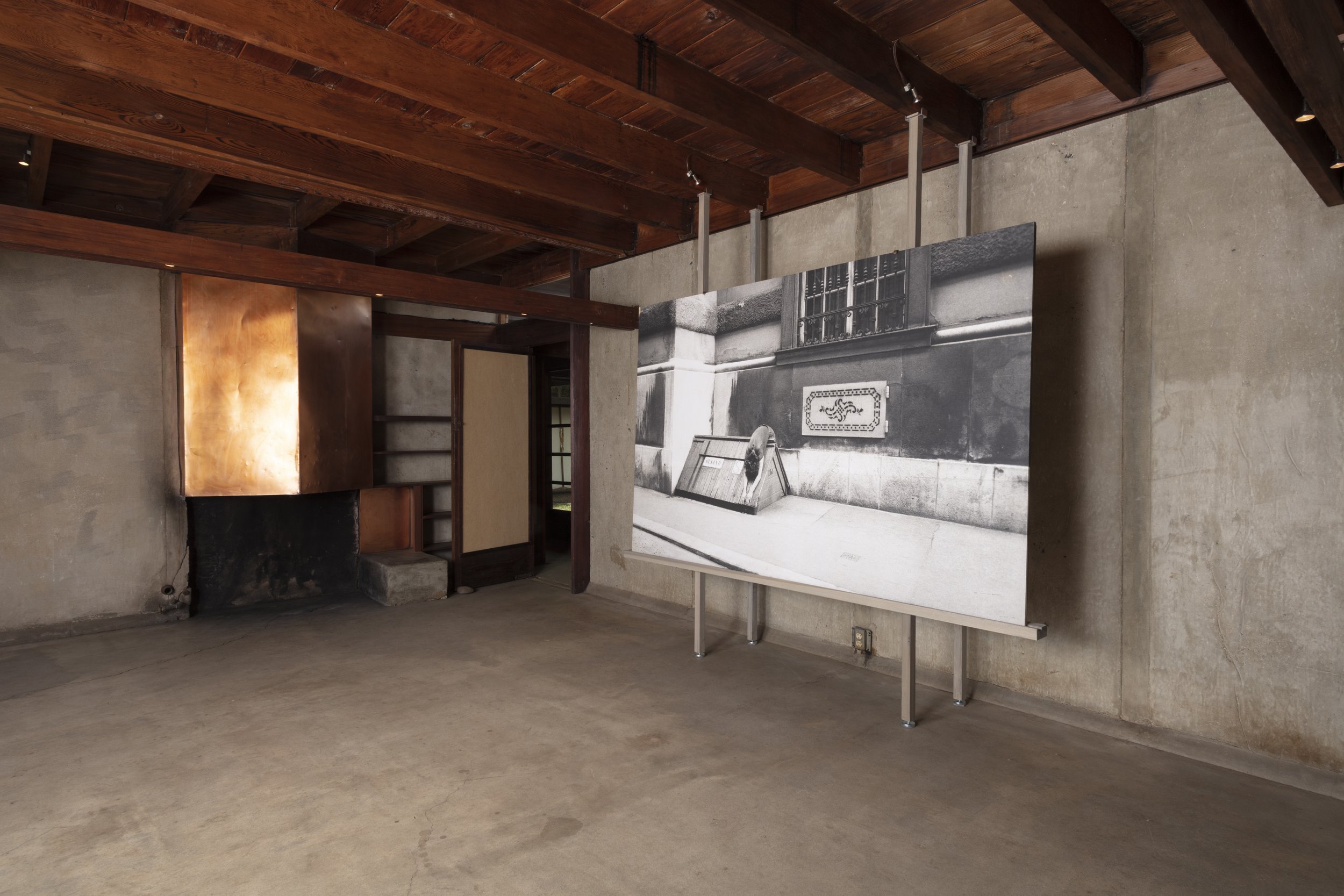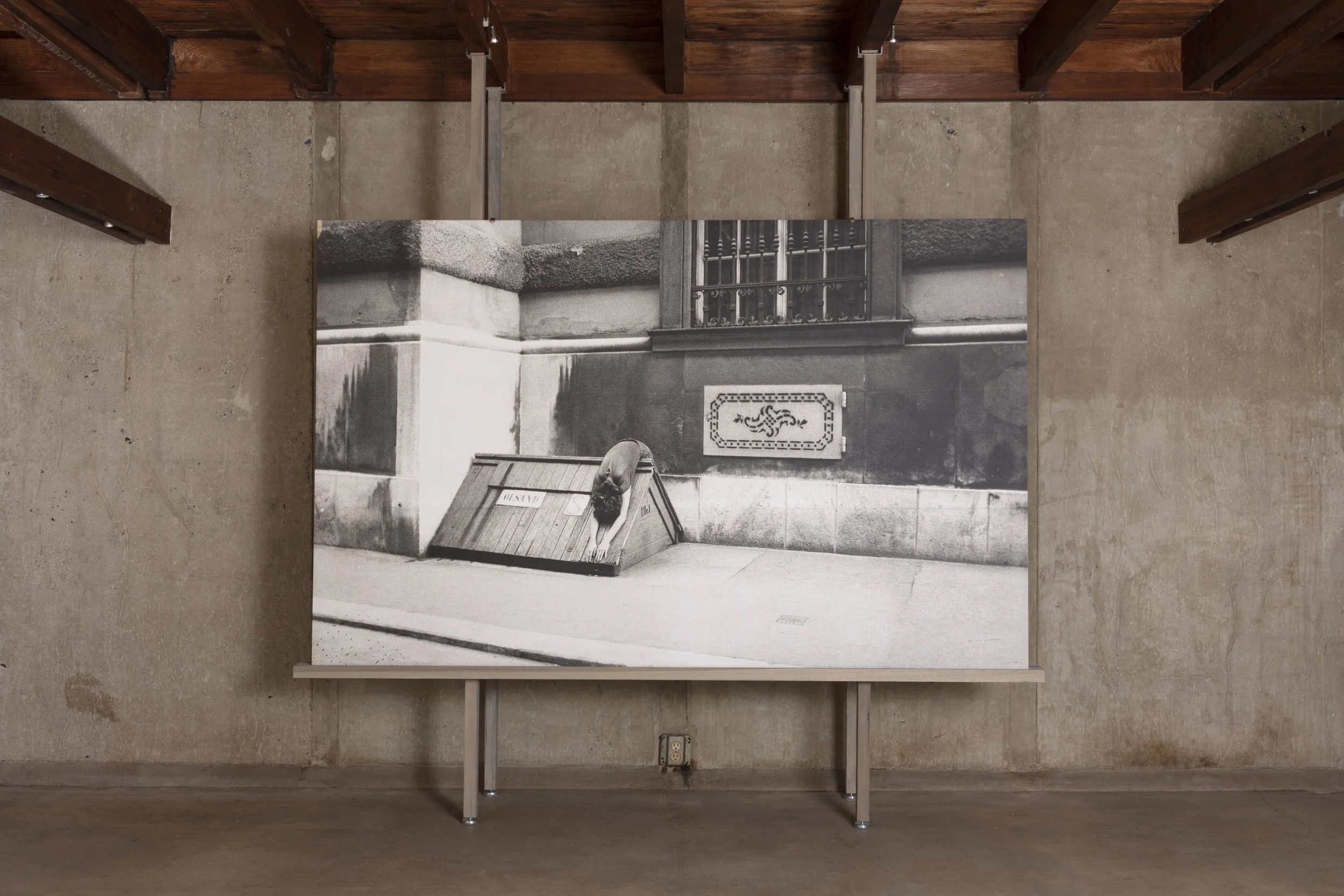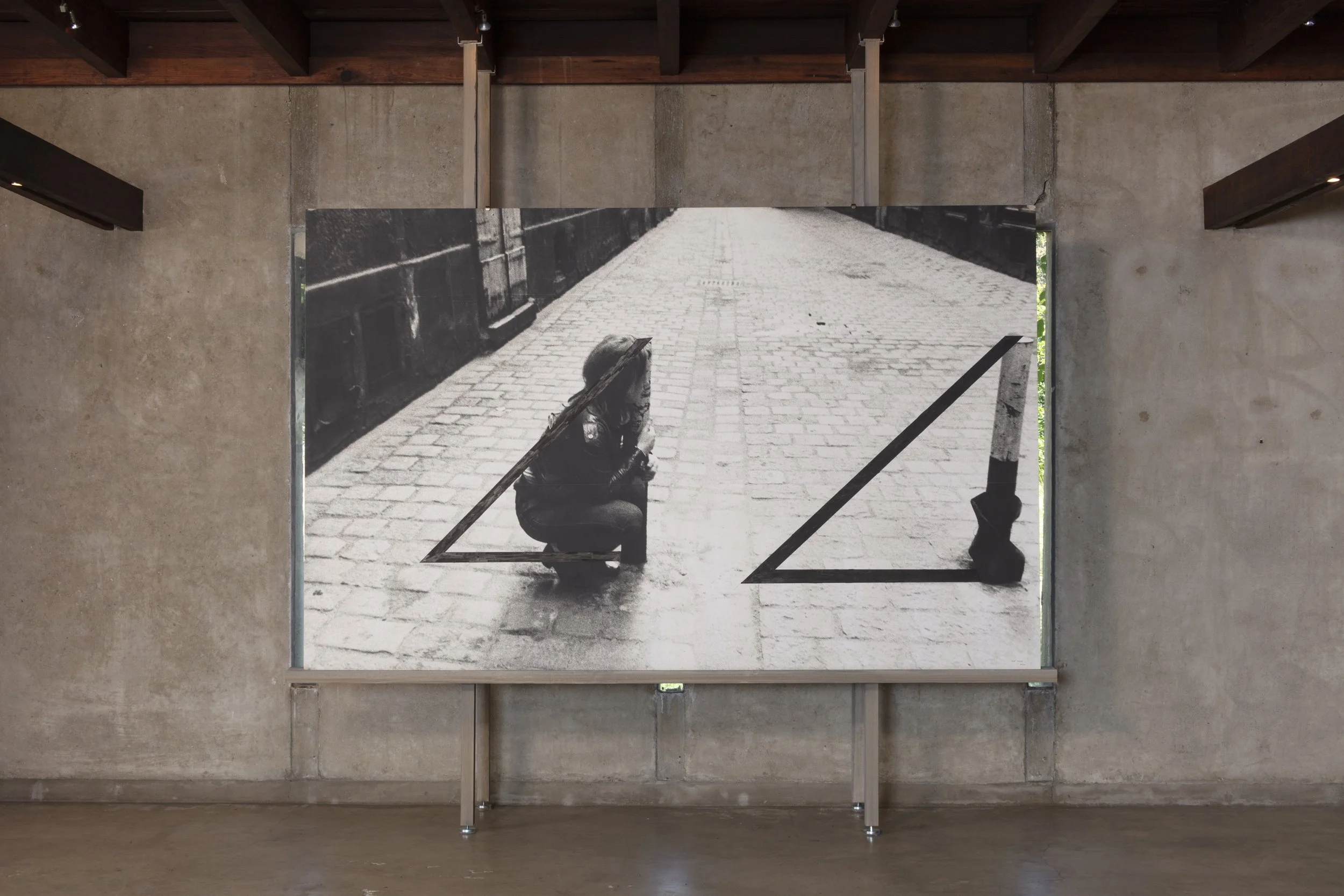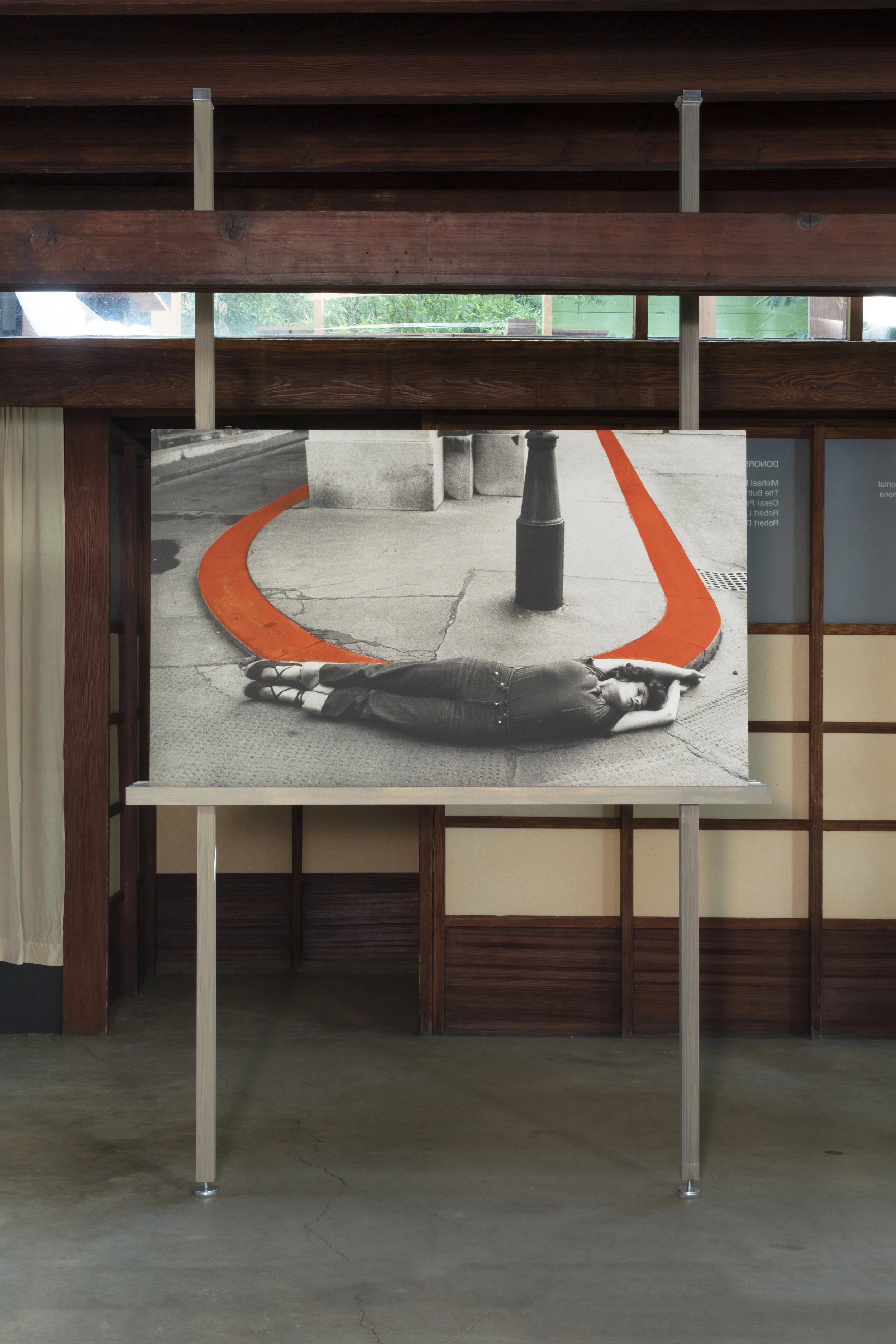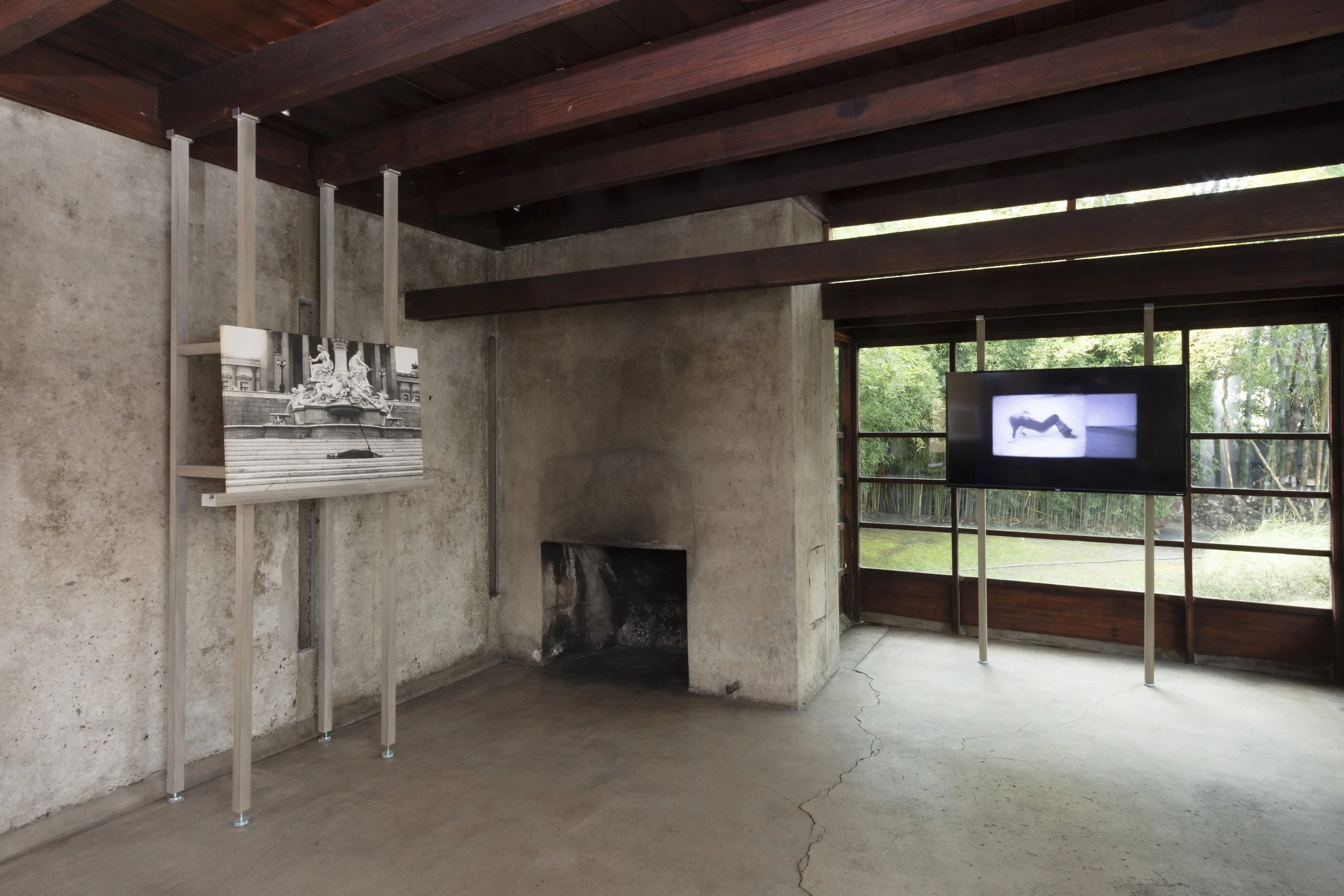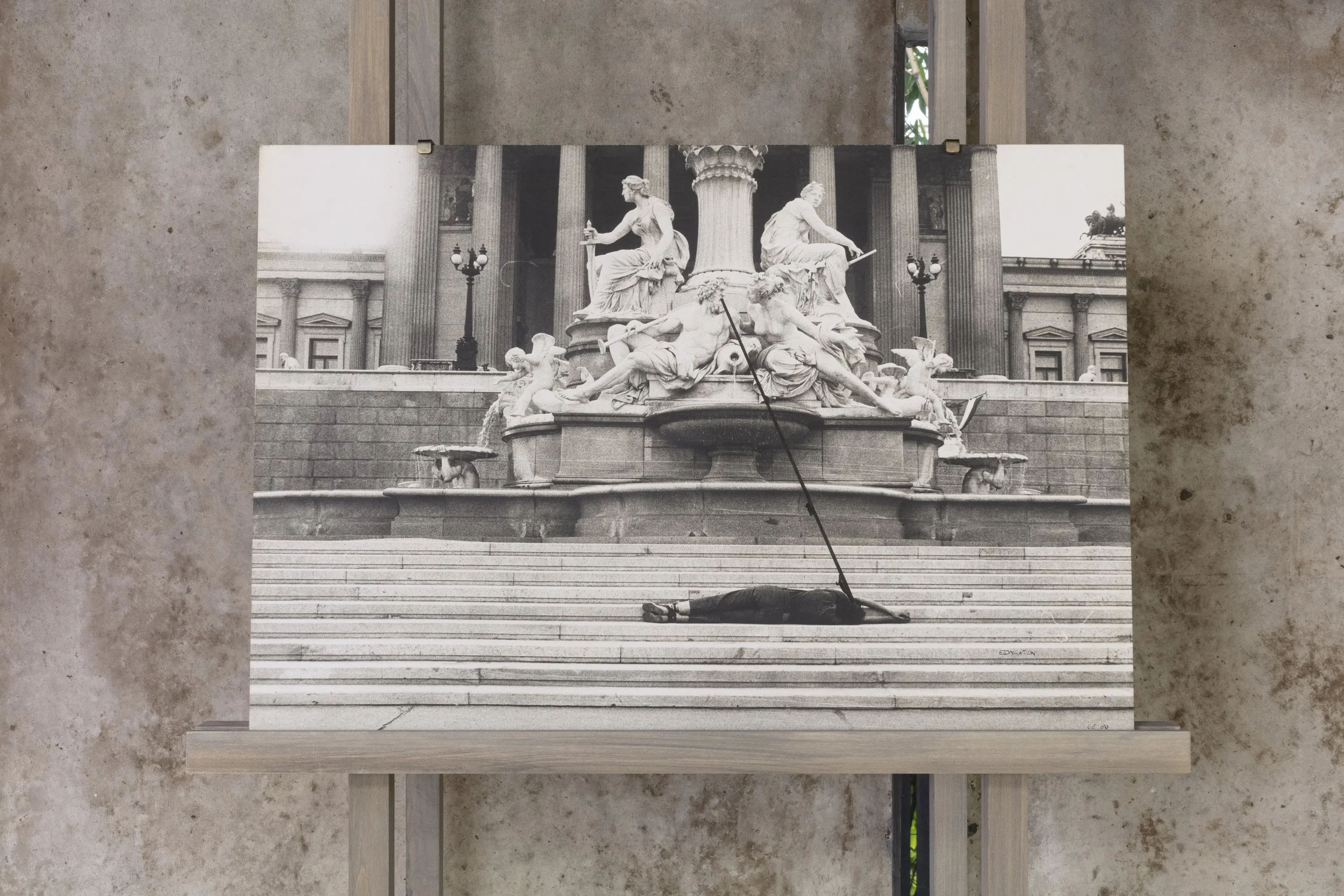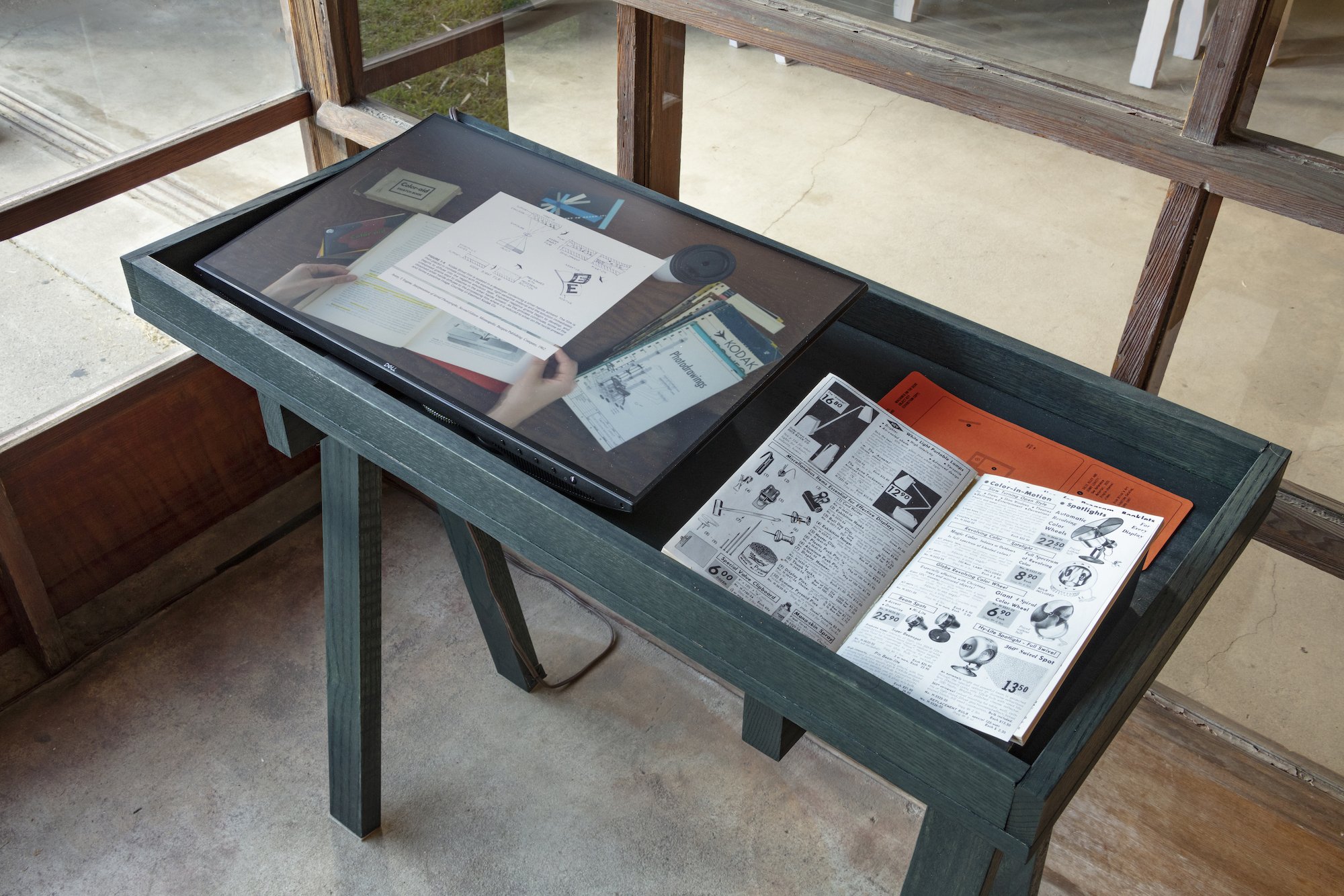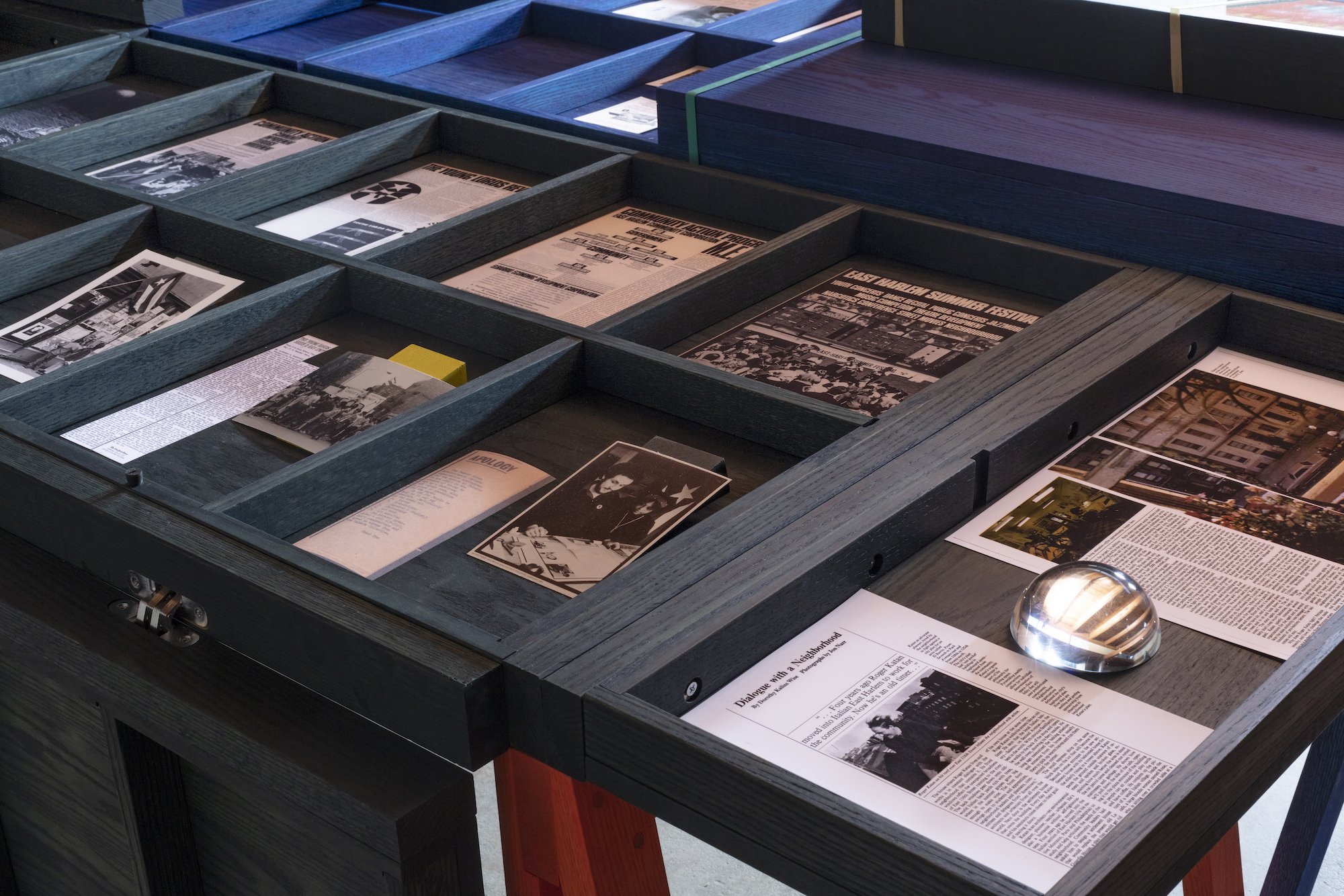Current and Upcoming Exhibitions
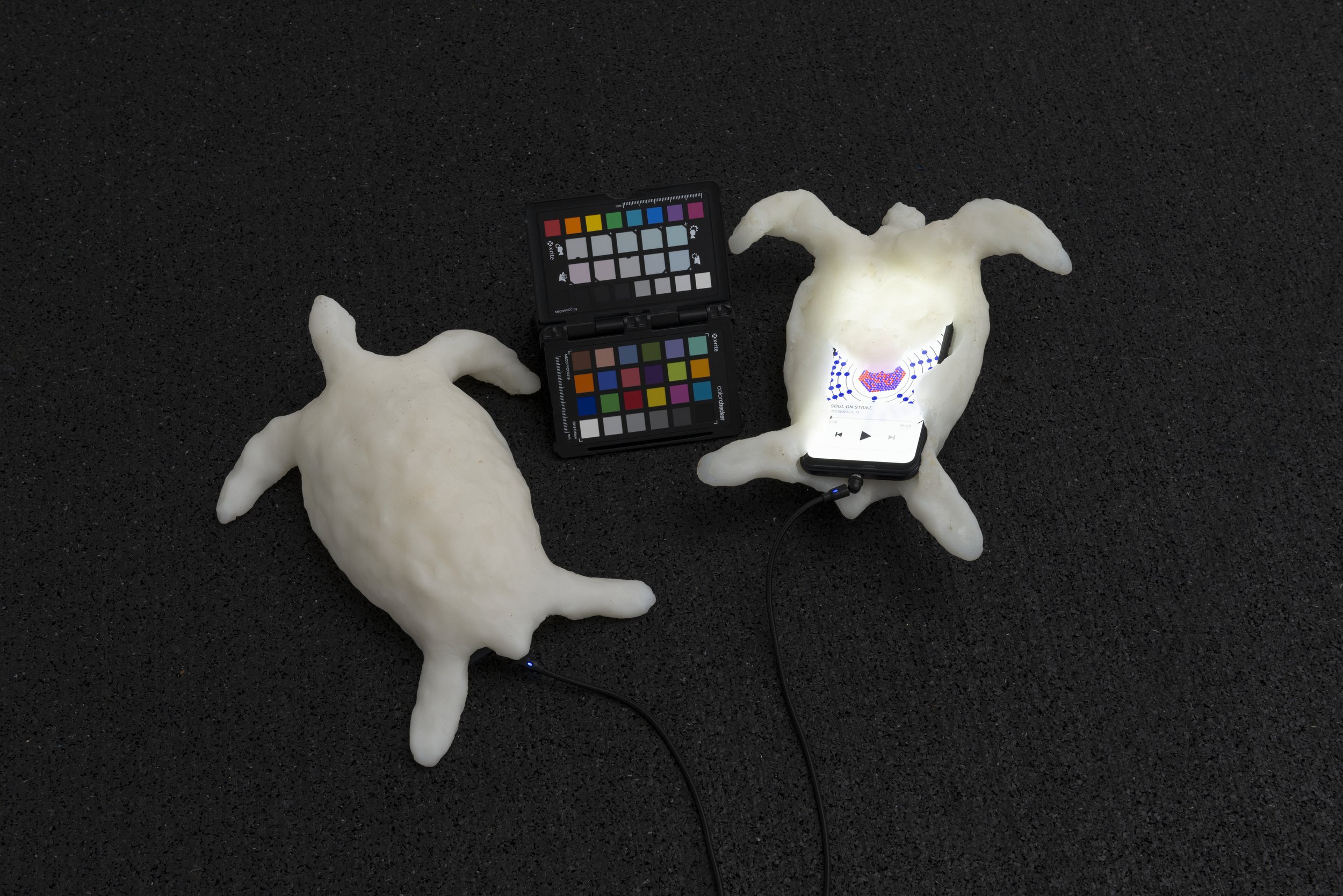
Half-Life
The MAK Center for Art and Architecture is pleased to present the 24th iteration of Garage Exchange Vienna—Los Angeles: Half-Life, with Katrin Hornek and Brody Albert.
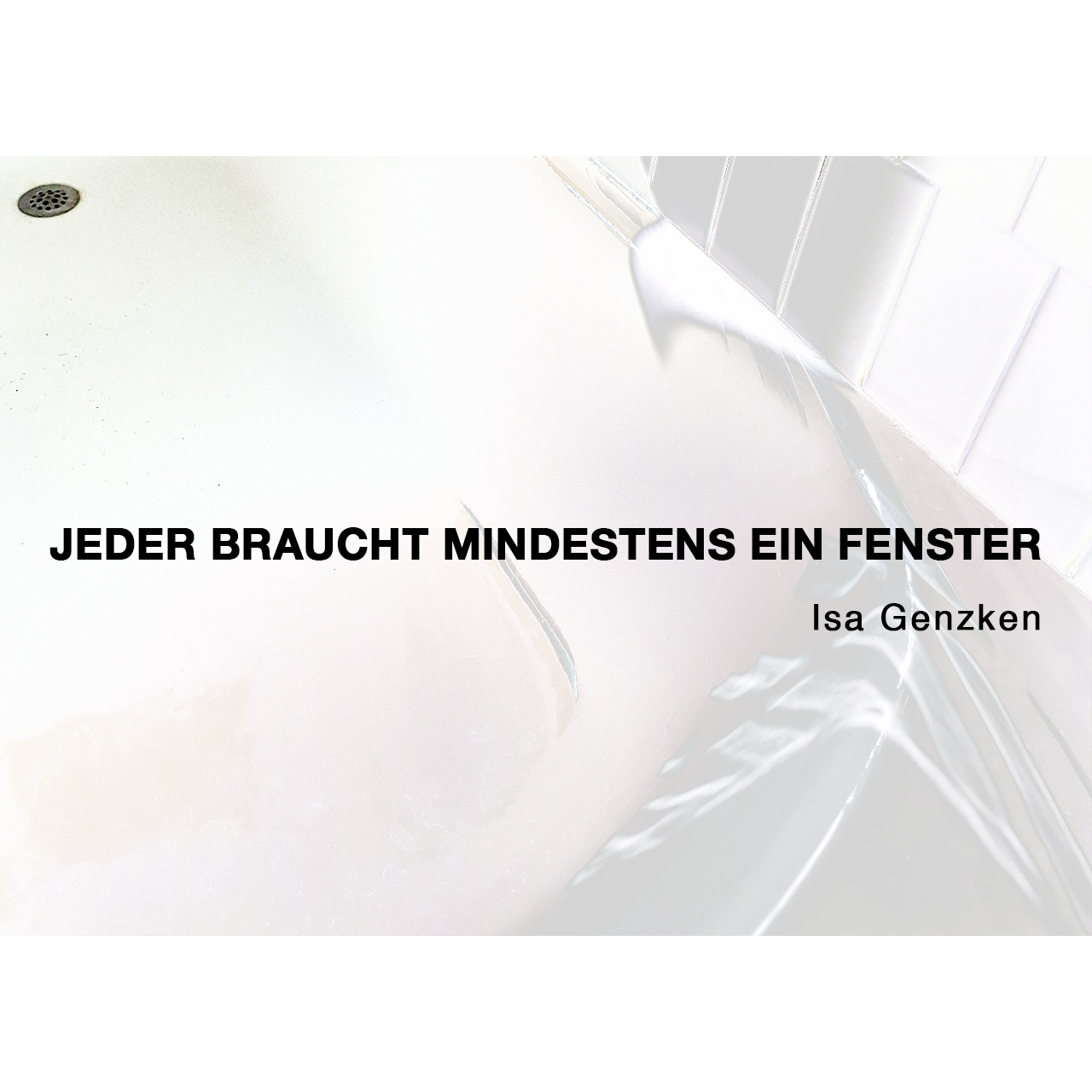
Final Projects: Group LV
Image Credit: Dominic Schwab, Uwe Brunner, Karl Holmqvist, Michèle Pagel, and Kris Lemsalu.
The MAK Center for Art and Architecture is pleased to announce Final Projects: Group LV, exhibiting bodies of work produced by our Artists and Architects-in-Residence, Uwe Brunner, Dominic Schwab, Karl Holmqvist, Michèle Pagel, and Kris Lemsalu. Final Projects: Group LV marks the culmination of the 55th iteration of the Artists and Architects-in-Residence Program at the Mackey Apartments.
Uwe Brunner and Dominic Schwab
For their Final Project, Uwe Brunner and Dominic Schwab, in collaboration with Bettina Katja Lange, reinterpret the Mackey Apartments as the pseudo-headquarters of the real estate media group Vapors to explore the correlations between the real estate market and the social media landscape in Los Angeles. Inspired by the city's commercial aesthetics and the prevalence of prop-tech platforms, they rebranded the property through both physical and digital interventions. The most prominent feature is a Vapors hot air balloon hovering above the property's courtyard, drawing attention as a landmark and a visual satire of LA’s eternal allure of sunset sales.
Additionally, the apartment building features a projection of their life writing process, undertaken during their residency. This interactive and spatial journal, composed of everyday fragments, offers a window into their lives and research at the Mackey Apartments, emphasizing the building's role as yet another Content House within the urban landscape of Los Angeles.
Uwe Brunner
Uwe Brunner is an architect, teacher, and researcher based in Vienna. He studied architecture at the Technical University of Vienna, at the School of the Arts Amsterdam, and received his master’s degree in arts and architecture from the Academy of Fine Arts in Vienna. From 2019 to 2024, he was a faculty member at ./studio3, Institute for Experimental Architecture at the University of Innsbruck. He is a co-founder of SOAP, an online architecture practice, and a co-founder of the Vienna Architecture Summer School. He is currently pursuing a PhD, focusing on the essay, its affective and cognitive modalities, and its potential for space-making within digital environments. His work has been widely screened and exhibited, including at the New Media Art Museum La Gaîté Lyrique in Paris, Centre d'Art Santa Mònica in Barcelona, CPH:DOX - Copenhagen International Documentary Film Festival, ETH Zurich, the Goethe-Institut in Beijing, and The Segal Center in New York, among many more.
DOMINIC SCHWAB
Dominic Schwab is an architect, teacher and researcher based in Vienna. He studied architecture at Vienna University of Technology, and holds a master degree in arts and architecture from the Academy of Fine Arts in Vienna. Since 2020, he has been a faculty member at the ./studio3, Institute for Experimental Architecture at the University of Innsbruck. He is currently pursuing a PhD with a research focus on the spectrality of media-technologies and how they inform, constitute & alter the archival paradigm in the age of digital media abundance. His work has been widely screened and exhibited, including Ars Electronica Barcelona Garden 2021, AUT Innsbruck 2021, Greenwich Heritage Gallery London 2016, Wien Museum 2016, Rundgang Academy of Fine Arts Vienna 2016/17/18 amongst others.He is co-founder of SOAP, some online architecture practice, co-founder of the Vienna Architecture Summer School and co-founder and board member of PARABOL, an association that aims at advancing artistic research.
Karl Holmqvist
Karl Holmqvist will present a new film, Meshes of the Mackey Apts, a remake and a tribute to the classic Maya Deren 1943 silent b/w film Meshes of the Afternoon shown together with preparatory drawings and props from the shoot. Additionally during his stay, Holmqvist has been writing poetry as a kind of journal or Los Angeles city portrait that he will present as a mini booklet OCEAN’S 24/7ELEVEN and spoken word performance during opening night.
Karl Holmqvist lives and works in Berlin. His work often includes writing in artist’s books, installations, video and performance. Recent one-person exhibitions include Laxart, Los Angeles, Fridericianum, Kassel, Centre d’Art Contemporaine, Geneva, Indipendenza, Rome (with Klara Liden). He has participated in the Venice Biennial in 2003 and 2011 and Performa, New York in 2005, 2007, 2013 and 2023. Karl Holmqvist’s works can be found in the collections of Moderna Museet, Stockholm, Le Musée d’Art Moderna de la Ville de Paris, Paris, Fridericianum, Kassel and Kunstverein für die Rheinlande und Westfalen, Düsseldorf among many other public and private collections.
Michèle Pagel and Kris Lemsalu
During her residency, Pagel investigated current and local political issues like social justice, classism, nationalism, white suprematism, and cultural differentiations. Working with locally sourced objects, she focuses on the universality of human body images to highlight the contradictions of national pride. She uses painting and collage technique to reflect the ills of white supremacy on the nation.
Lemsalu presents two sculptures, Woundlicker and Amber Takes A Long Time. Woundlicker is constructed of ceramics, wood and special woven textiles. The woven structures are done in collaboration with local artists. Amber Takes A Long Time utilizes vintage traffic light from Hollywood film sets along with ceramics, wood, and mixed media. In both works Lemsalu incorporates the landscape of the inner psyche and the local communities.
Collaboratively, Pagel and Lemsalu produced a cyanotype textile wall piece that looks to form solidarity amongst artists and all creative powers.
For the exhibition opening, Pagel invites the music composer Mariela Gutierrez with her project SITES to perform live as part of her underground Cassette-Label “RatRights”.
MICHÈLE PAGEL
Michèle Pagel has been working as a freelance sculptress in Vienna since 2012. In 2015, they started teaching sculpture as an University Assistant at the ceramics department at the Art University in Linz, Austria. Pagel continued this teaching job until 2019, and also ventured a three month field trip to Uganda, Afrika in 2018. In 2021, they established a self-employed company in order to professionalize their artistic career and to concentrate exclusively on their own projects and exhibitions. The same year, Pagel started collaborating with the Viennese Gallery, MeyerKainer which is representing their work in solo exhibitions and art fairs. Pagel has participated in various international group shows and showcased their artworks in several European Museums and Institutions.
KRIS LEMSALU
Kris Lemsalu was born in 1985 in Tallinn, Estonia, and lives and works between Vienna and Tallin. She creates mixed-media sculptures, installations and performances with unexpected materials. Lemsalu’s pieces evoke the bestial side of human beings and civilizations, and are often underscored by feminist themes. Lemsalu has shown as part of Performa 17 (2017), DRAF performance night (2017), Bunshitu Gallery, Tokyo (2015), Ferdinand Bauman Gallery, Prague (2015) and is represented by Koppe Astner, Glasgow and Temnikova & Kasela, Tallinn. Lemsalu will represent Estonia at the Venice Biennale 2019.
Artists
The Artists & Architects-in-Residence Program at the Mackey Apartments is funded by the Federal Ministry for Arts, Culture, the Civil Service and Sport, in cooperation with the MAK — Museum of Applied Arts, Vienna, with additional support from the Austrian Consulate General Los Angeles.
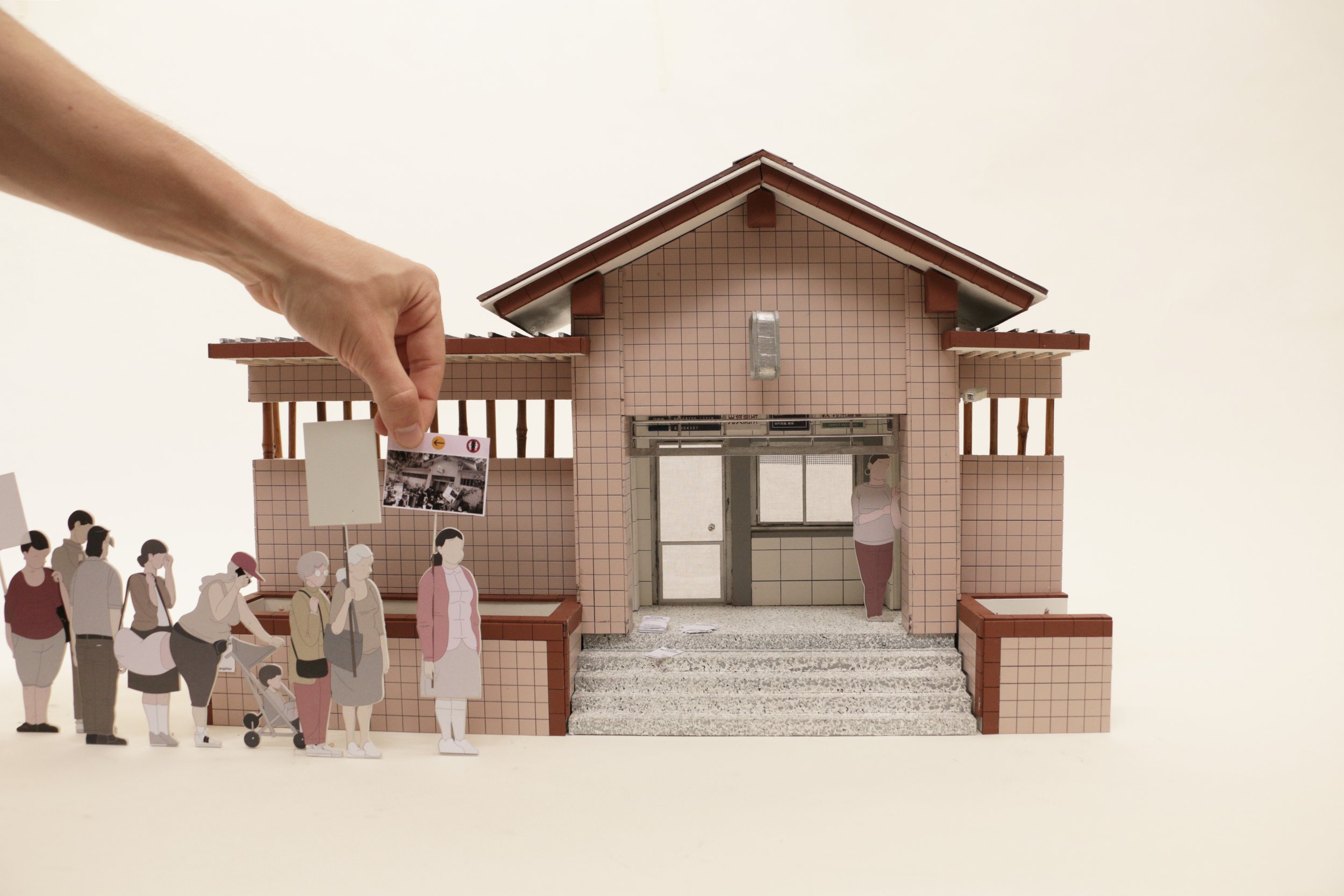
Entourage
Image:“Your Restroom Is a Battleground”, 2021, Matilde Cassani, Ignacio G. Galan, Ivan L. Munuera, J. Sanders. Photograph by Natalia Guardia
Entourage presents the work of contemporary architects who confront and expand the ways bodies serve as units of measure for architecture. The exhibition centers research-based practices and projects across multiple sites: in people drawn by architects, within the political space of restrooms, and through the commercial fixtures of our daily lives. The exhibition presents works and documentations by MOS (Michael Meredith and Hilary Sample), Your Restroom is a Battleground (Matilde Cassani, Ignacio G. Galán, Iván L. Munuera, Joel Sanders), and Strat Coffman.
Alongside the radical visioning of buildings, architects have also re-envisioned the index of people, bodies, figures, and actors that populate their buildings. In Unfinished Encyclopedia of Scale Figures, Michael Meredith and Hilary Sample of MOS indexed over 2000 people found in architectural drawings, collages, sketches, and renders. “It is impossible to represent architecture without representing the human,” writes MOS. Their accompanying work Selfie Curtain is an interactive textile work that gathers these bodies into a playful procession.
Your Restroom is a Battleground (YRIAB) is a collaboration between Matilde Cassani, Ignacio G. Galán, Iván L. Munuera, Joel Sanders examining bathrooms as sites of protest. Originally exhibited as a dioramic model in conjunction with the Restroom Pavilion in the 2021 Venice Biennale, YRIAB presents seven stories of bathrooms as contested spaces around the globe. Rather than treat restrooms as glorified utility closets, the project insists on acknowledging the entanglement of policy, finance, race, gender, ability, health and environment in those spaces. By examining toilets as technological sites, YRIAB show how design and policy deny, exclude, or overdetermine certain bodies that need to excrete.
Erotica Generica is an ongoing research project by Strat Coffman that examines commercial fixtures and standard codes of architecture as sites where bodily elements such as bacteria, oils, and heat are transferred. Queering our understanding of generic fixtures, Coffman explores how everyday objects such as stair handles, doorknobs, and grips can be re-envisioned as intimate sites of transfer between one body to another. By accommodating acts of touching, architecture relishes in, rather than represses, its capacity to open pathways for anonymous contact.
Curated by MAK Center Director Jia Yi Gu, the exhibition takes place in the Schindler House, an early modernist experiment that married the body to the natural environment. By centering new definitions in bodily rights, experiences, and forms, the exhibition brings contemporary practices working on the architectural governance of the body into conversation with early modernist ideas at the Schindler House.
Artists
MOS
MOS is a New York–based architecture studio, founded by principals Michael Meredith and Hilary Sample in 2005. An internationally recognized architecture practice, MOS was the recipient of the 2015 Cooper Hewitt, Smithsonian Design Museum National Design Award in Architecture, the 2010 American Academy of Arts and Letters Architecture Award, and the 2008 Architectural League of New York Emerging Voices Award. Individual works have similarly received numerous awards and distinctions, most notably: the 2015 Global Holcim Award for sustainable construction (Asia-Pacific Region) for Community Center No. 3 (Lali Gurans Orphanage); the cover of Abitare and an AIA NY State Award of Excellence for School No. 1 (Krabbesholm Højskole), the 2014 accession of both the firm’s modular, off-grid House No. 5 (Museum of Outdoor Arts Element House) into The Museum of Modern Art, Architecture and Design Collection; the acquisition of House No. 3 (Lot No. 6/Ordos) into the permanent collection of The Art Institute of Chicago; and the selection of Pavilion No. 4 (Afterparty) for the 2009 MoMA PS1 Young Architects Program. Recent work includes: House No. 10, a private residence in Upstate New York; an all-aluminum open-air school for children in Versailles, France; and the Laboratorio de Vivienda, a 9-acre master plan and welcome center in Apan, Mexico. Recent and forthcoming publications, both products of and surveys on MOS’s work, include MOS: Selected Works (Princeton Architectural Press, 2016); El Croquis No. 184 (2016); An Unfinished Encyclopedia of Scale Figures Without Architecture (MIT Press, 2019); and Houses for Sale (CCA/Corraini, 2019).
YOUR RESTROOM IS A BATTLEGROUND
Your Restroom Is A Battleground builds upon the collective experience of the four participating teams. Matilde Cassani addresses toilets in the framework of her interest in the spatial implications of everyday multiculturalism in the contemporary Western city. Ignacio G. Galán considers the relationship of architecture and politics and frames the study of restrooms in response to assimilationist and technocratic ideologies —following his work on nationalism and migration and his interest in critical access and anti-ableism. Ivan L. Munuera explores the intersection between culture, technology, politics, and bodily practices, understanding restrooms as collective embodiments, challenging their materiality to understand them as both infiltrating and being infiltrated by technologies, beings, regulations, and policies. The contribution of Joel Sanders, principal of JSA/MIXdesign is informed by Stalled!, a cross-disciplinary design/research project consisting of toolkits and prototypes for safe, accessible public restrooms that meet the needs of differently embodied and identified people regardless of age, gender, race, faith or disability.
STRAT COFFMAN
Strat Coffman uses the multi-facing tools of architecture to explore how capital, institutions, and design discourses conspire to produce material, social, and epistemic bodies. They were a 2022-2024 Architecture Fellow at University of Michigan. They hold a BA from Wesleyan University and M.Arch from the Massachusetts Institute of Technology, where they received the Imre Halasz Thesis Prize and the AIA Henry Adams Medal. They have also received the 2024 Architectural League Prize. Their work has appeared in Log, the MIT List Visual Arts Center, and the Multimedia Anthropology Lab at University College London. They were previously an editor of Thresholds 48: Kin, a fellow at the MIT Transmedia Storytelling Initiative, and a 2023 artist-in-residence at the Goethe Institut.
Entourage is made possible, with generous support from the Los Angeles County Department of Arts and Culture and the California Arts Council

Kathi Hofer and Preserve Bottle Village Committee
The MAK Center for Art and Architecture is pleased to present the 234d iteration of Garage Exchange Vienna—Los Angeles: Kathi Hofer and Preserve Bottle Village Committee at the Mackey Apartments Garage Top Gallery.

Final Projects: Group LIV
Image Credit and Courtesy: Anna-Sophie Berger, Bianca Gamser, and Evan Ifekoya.
The MAK Center for Art and Architecture is pleased to announce Final Projects: Group LIV, exhibiting three bodies of work produced by our Artists and Architects-in-Residence, Anna-Sophie Berger, Bianca Gamser, and Evan Ifekoya. Final Projects: Group LIV marks the culmination of the 54th iteration of the Artists and Architects-in-Residence Program at the Mackey Apartments.
Hours
OPENING RECEPTION FOR FINAL PROJECTS: LIV
Mackey Apartments and Garage Top
Thursday, March 7, 6pm - 8pm
ANNA-SOPHIE BERGER AND BIANCA GAMSER EXHIBITIONS
Mackey Apartments and Garage Top
Friday, March 8 — Sunday, March 10, 1 pm-5 pm
EVAN IFEKOYA INTERACTIVE INSTALLATION
Original Muscle Beach, Santa Monica
16 Arcadia Terrace
Santa Monica, CA 90401
Friday, March 8 and Saturday, March 9, 11 am-2 pm
Mackey Apartments and Garage Top
Sunday, March 10, 2 pm-6 pm
Artists
ANNA-SOPHIE BERGER
Drawing from her 2022 exhibition in Mexico City titled Wealth and Propriety, Anna-Sophie Berger continues her investigation into historical and contemporary notions of sumptuary laws and the economical relevance of scarcity as it pertains to materials in general and to clothing and fabric specifically. Berger devised a faux-scientific graph that connects clothing styles and dimensions with economic and moral qualities: length pertaining to relative wealth, width pertaining to relative propriety. In an initial series of graphic wall pieces, she labeled the roughly body sized line drawings based on her graph with corresponding word combinations such as “wealthy and lewd” or “poor and proper”.
The new series for her project in LA attempts the abstraction of these line drawings into graphic shapes applied in fabric based stitched wall panels and by consequence a blurring of their if purely fictional pretension at the legibility of clothing signs.
Anna-Sophie Berger (b. 1989, Vienna, Austria) is an artist living and working in New York and Vienna. She has had solo exhibitions at MAK, Vienna (2023); Bonner Kunstverein, Bonn (2020); Cell Project Space, London (2019); MUMOK, Vienna (2016); Kunsthaus Bregenz (2016); Ludlow 38, NY (2015); White Flag Projects, St. Louis (2015); and Belvedere21, Vienna (2014); among others. She has recently participated in group exhibitions at the Pictures Collection of the Academy of Fine Arts, Vienna (2022); The Glucksman, Cork (2022); MACRO Museum, Rome (2021); MAK, Austria (2019); Kunsthalle Wien, Vienna (2019); Frans Hals Museum, Haarlem (2018); S.M.A.K., Ghent (2018); Contemporary Art Centre, Vilnius (2018); Kestnergesellschaft, Hannover (2017); Kunstverein Munchen, Munich (2017). She is the recipient of the 2017 Ars Viva Fine Arts Prize in Germany and the 2016 Kapsch Contemporary Art Prize, Austria and a 2023 recipient of the Pollock Krasner grant.
BIANCA GAMSER
Utilizing origin myths about the beginning of architecture, Bianca Gamser works to interrogate these supposed narratives, dating back to Vitruvius. At their core, this historical framing works in two parts, to separate humans from their natural environment; architecture as a shelter from weather; and to build a position to rebuke; the modernist incorporation of surroundings into the architecture itself. The latter can also be seen in R.M. Schindler’s writings, “The man of the future does not try to escape the elements. He will rule them.” Through the lens of contemporary construction practices and its harmful effects on the environment, the notion of architecture providing refuge from nature has turned into its active destruction of the natural environment. The effects can also be seen through unusual weather patterns, including recents years of heavy rainfall in Southern California, following years of drought.
Gamser ties these ideas together by making the architecture itself the collection site and source of rainfall. Rather than architecture as a protective force from the natural environment, R.M. Schindler’s Modernist Mid-City Mackey Apartments functions as the ecosystem which produces rain. Here the separations outlined in the origin myth dissolve to create a holistic architecture that works with the environment, rather than against it.
Bianca Gamser, is a Vienna-based architect and art historian who studied at both the Vienna University of Technology and the University of Vienna. Gamser's work aims to highlight potentials and grievances through the tools of architecture, often through interventions in public space.
She has participated in exhibitions and workshops in Europe, including the Lakeside Dancers Club, based on a design by Yoshiharu Tsukamoto, Atelier Bow-Wow for HORST arts & music festival in Holsbeek, at the Vienna Biennale with the installation Ephemeral Temporalities and the Vienna Design Week with the group work VEBSHTUL. Several of her works, including her latest installation STILL FRIEDEN were awarded with grants and special recognitions. Besides her artistic practice at the intersection of art and architecture, Gamser has been active in various Viennese collectives, works as a set designer and has taught at the Vienna University of Technology.
EVAN IFEKOYA
Thursday, March 7, 6-8pm, Mackey Apartments
Friday, March 8, 11am-2pm, Original Muscle Beach, Santa Monica
Saturday, March 9, 11am-2pm, Original Muscle Beach, Santa Monica
Sunday, March 10, 2-6pm, Mackey Apartments
Through their engagement with the city, Evan Ifekoya traces the history of Los Angeles public exercise spaces and centers strength training as a physical and spiritual guide. As public spaces that focus on the development and presentation of the body, Ifekoya prioritizes bodies that are often marginalized from these spaces.
Constructing an intervention over two sites, their live/work space at the Mackey Apartments and Original Muscle Beach, Santa Monica, Ifekoya brings ‘Calabash, Kettlebell and Cascarilla’ - an interactive installation and guided audio journey.
At the Original Muscle Beach, Santa Monica (the 1930s era outdoor gym, not to be confused with the later Muscle Beach Venice Beach) Ifekoya brings an interactive sound installation and provides guidance on pull up progressions and other ways of making use of the equipment. With an emphasis on the importance of good technique and form; this interactive installation offers affirmation, encouragement, and support within an intimidating environment for those not familiar.
Through these interventions, Ifekoya makes a ceremony of adaptation and strength, creating a dialogue between notions of health and harmony.
Evan Ifekoya is an interdisciplinary artist seeking greater embodiment for all, through sound. Their work in community organizing, installation, performance, text and video is an extension of their calling as a spiritual practitioner. They view art as a site where resources can be both redistributed and renegotiated, whilst challenging the implicit rules and hierarchies of public and social space. Strategies of space holding through architectural interventions, ritual and immersive sonic installations enable them to make a practice of living in order not to turn to despair.
They established the collectively run and QTIBPOC (queer, trans*, intersex, black and people of color) led Black Obsidian Sound System (B.O.S.S.) in 2018. Upcoming presentations include immersive installations for ARoS Denmark (2023), Lagos Biennial and ICA VCU (both 2024). They have presented exhibitions, moving image and performances across UK, Europe and Internationally, most recently: Guest Artist Space Lagos (2023), a solo exhibition at Migros Museum, Zurich and a moving image commission with LUX in collaboration with University of Reading (2022); Herbert Art Gallery and Museum as nominees of the Turner Prize (with B.O.S.S. 2021); Gus Fischer New Zealand (2020); De Appel Netherlands (2019) and Gasworks London (2018).
The Artists & Architects-in-Residence Program at the Mackey Apartments is funded by the Federal Ministry for Arts, Culture, the Civil Service and Sport, in cooperation with the MAK — Museum of Applied Arts, Vienna.
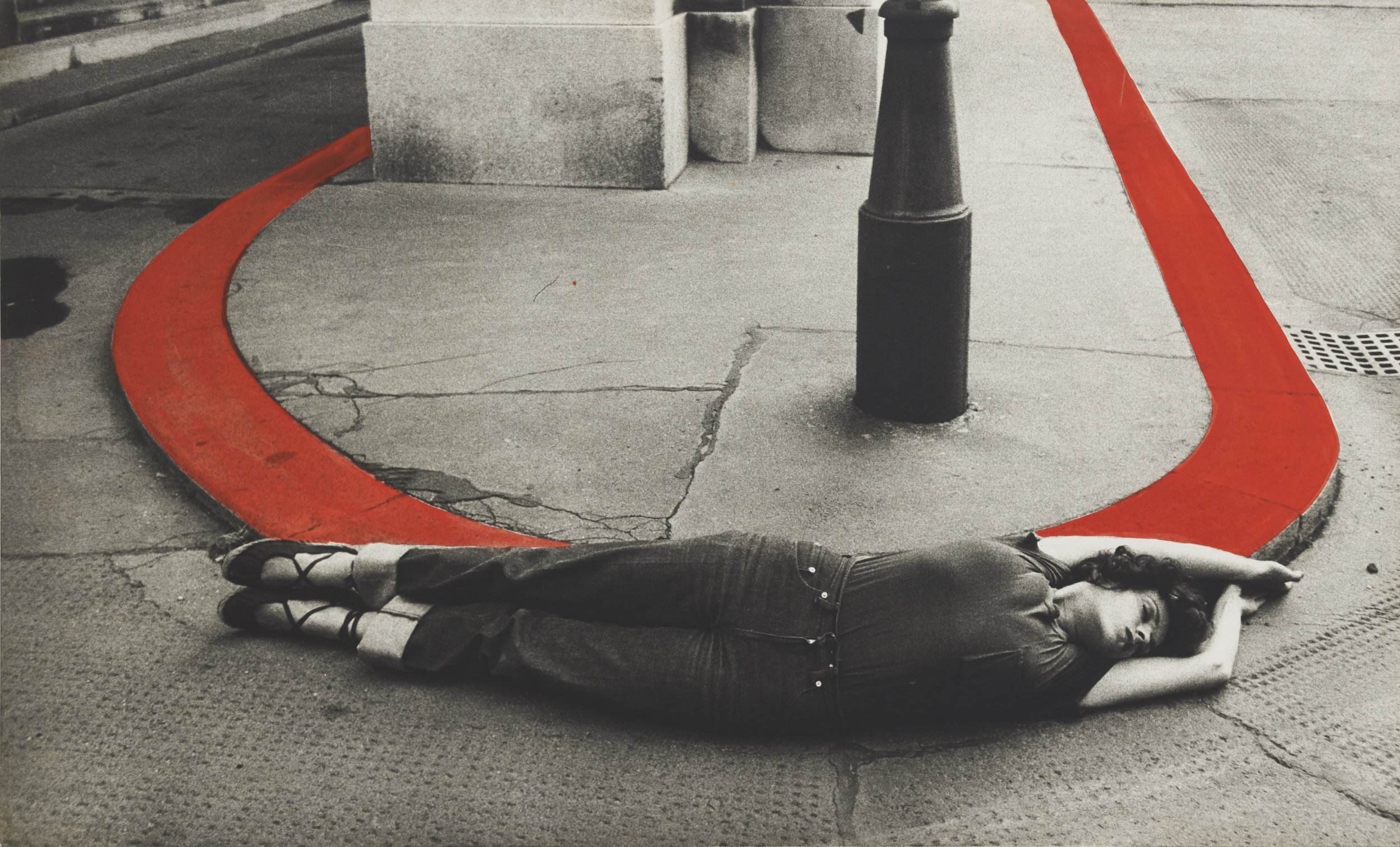
VALIE EXPORT: Embodied
VALIE EXPORT, Einkreisung, 1976. Black and white silver gelatin print on baryta paper laid on chip board, Collection Thaddaeus Ropac, © VALIE EXPORT / Bildrecht Wien, 2024
VALIE EXPORT’s work has redefined the fields of conceptual art, performance, and expanded cinema. Since the 1960s, her early projects have blurred the boundaries between photography and documentation, performance and action, often by utilizing the female body as prop and provocation to classical regimes of architecture. The ‘photo-graphic’ series, Body Configurations (1972-1976) captures direct interventions through bodily insertions into public space. VALIE EXPORT: Embodied presents select works from this seminal series, reflecting her early investigations into the politics of space, image-making, and the body as both an ideological and technological device. Accompanying the photographic series in the exhibition are two video works by VALIE EXPORT, Adjunct Dislocations (1973) and Syntagma (1984), which present the artist’s filmic inquiries into the real and the representational.
Working across the mediums of performance, film, photography, video, sculpture, and installations, EXPORT’s work engages with the construction and representation of the female body, confronting ideas of sexuality, intimacy, and transgression in both private and public arenas. Her first solo presentation in Los Angeles since 2001, the exhibition centers on EXPORT's early artistic explorations, expanding on the production of meaning and materiality in film, photography, and performance, while challenging the social function of women and the ideologies of space and the built environment.
The exhibition positions these influential works in dialogue with a contemporary performance program featuring Los Angeles-based artists responding to VALIE EXPORT’s work and the Schindler House.
VALIE EXPORT
A pioneer in film, video and installation art, VALIE EXPORT has produced one of the most significant bodies of feminist art in the post-war period. Her groundbreaking films and performances in the 1960s and 1970s introduced a new form of radical, embodied feminism to Europe, examining the politics of the body in relation to its environment, culture and society. The multi-disciplinary nature of EXPORT's 'Expanded Cinema' practice and use of her own body as an artistic medium positions her as one of the earliest performance artists alongside Joseph Beuys and Allan Kaprow.
VALIE EXPORT lives and works in Vienna, where she co-founded the Austrian Filmmakers Cooperative. Since 1968, she has taken part in numerous international exhibitions, including documenta 6 and 12 (1977 and 2007) and the Austrian Pavilion at the Venice Biennale in 1980. In recent years, the Staatliche Kunsthalle Baden-Baden (2020); Neue Berliner Kunstverein (2018); Lentos Kunstmuseum Linz (2017); Kunsthaus Bregenz (2011); Belvedere Museum, Vienna (2010); Israel Museum, Jerusalem (2009); and Centre Pompidou, Paris (2007) have devoted major solo exhibitions to her work. EXPORT has taught at a number of international institutions, including the University of Wisconsin, San Francisco Art Institute and University of the Arts in Berlin. From 1995–2005 she was professor of multimedia and performance at the Academy of Media Arts in Cologne. In 2019, she was awarded the Roswitha Haftmann Prize in recognition of her outstanding contributions to the visual arts. VALIE EXPORT received the Max-Beckmann-Prize of the City of Frankfurt 2022.
Sunday, March 10, 2024
12—1 pm
Saturday, March 23, 2024
11 am—6 pm
Friday, March 29, 2024
7—9 pm
Saturday, March 30, 2024
7—9 pm
VALIE EXPORT: Embodied is organized by MAK Center Director Jia Yi Gu with Seymour Polatin, Exhibitions and Programs Manager, Brian Taylor, Curatorial Assistant, and Maeve Atkinson, Education and Engagement Coordinator.
The performance program In Their Own Image is curated by Chloë Flores and features new work by performing artists Zackary Drucker, Sierra Fujita, Emily Lucid, Lara Salmon, Andrea Soto, and Dorian Wood. The program is in partnership with homeLA.
The exhibition and program is made possible with support from Thaddaeus Ropac Gallery, Betsy Greenberg, the Austrian Consulate General Los Angeles, the Los Angeles County Arts and Culture Department, and MAK Center’s Centennial Council.
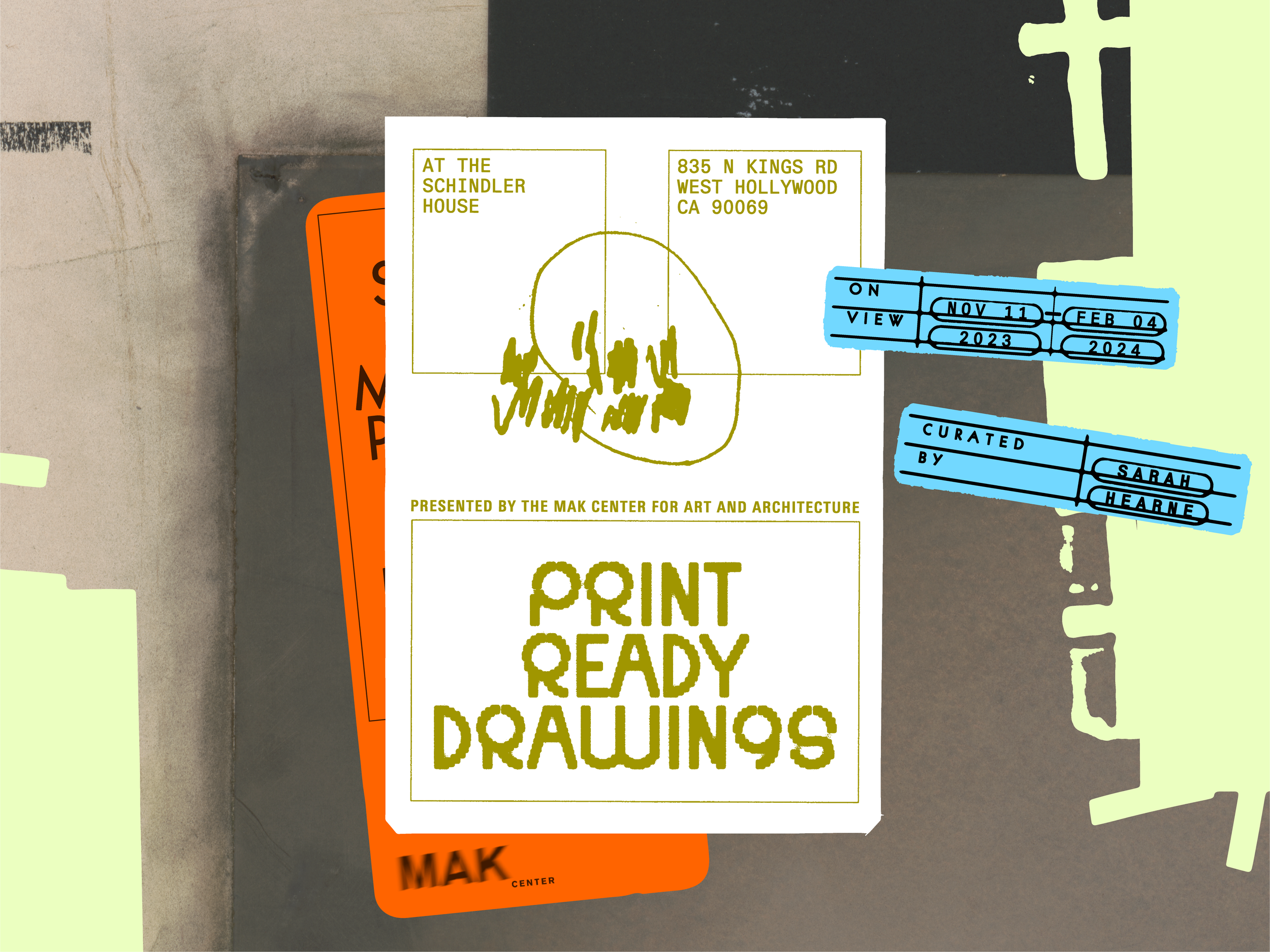
Print Ready Drawings
Image: Christina Huang
Between 1950 and 1989, an intense print culture emerged when architects began to engage with graphic media, producing drawings and collages intended for reproduction and publishing. Print Ready Drawings investigates the process behind these printed images. Emblematic of this period, composite and mechanical documents were produced from graphic supplies such as photographic papers, Letraset transfer sheets, Rapidograph pen sets, and other graphic templates. The exhibition features prints and reproductions, exploring a history of architectural authorship not via singular authors but through an examination and display of the material supplies and techniques of drawing production.
From “instant pictures” to “rapidraw” systems, the items crowding the architect’s desk from the mid-century reflected a preoccupation with speed and efficiency. With a flourishing of supplies and materials that transformed the work of many in the graphic fields, this was a period in which architects engaged widely with technologies of printing and printmaking. Whether in the service of the distribution of working drawings, or in the making of carefully stamped lithographic multiples, architects worked to make their architecture print ready.
Through a selection of 12 case studies, Print Ready Drawings highlights these miniature paper landscapes. Across their surfaces are expressions of control: annotation marks, enlargement instructions, manufacturer tags, and watermarks, along with evidence of any number of unacknowledged contributors.
Drawings in this exhibition are viewed as microcosms of the material world, and their convergence in each document tells a social and production history of architectural work. Their organization into technical affinities produces curious pairings, like Lina Bo Bardi and Roger Katan, whose magazine cover designs constitute parallel case studies of contextual and material appropriation. Other groupings include scientific illustrator Gloria Brown Simmons, Eames Office, and Herbert Bayer’s World Geo-Graphic Atlas.
Print Ready Drawings also includes a variety of production ephemera, technical manuals, and samples, alongside artist’s films that turned the camera inward towards the process itself, including Richard Serra’s Color-Aid film. Several drawings featured in the exhibition, considered too fragile to be exhibited, are replicated through a process of material and technical research in conservation labs, manufacturing workshops, eBay, and oral histories. This research is documented in films made by Julie Riley and Jenny Leavitt that interpret and translate historical materials and modes of making.
The site of architectural authorship has long been found in drawings. By anonymizing the technical and foregrounding original marks and signatures, drawings played a crucial role in prioritizing cognitive acts over material labor — thus obscuring their intersection. This exhibition examines the architectural drawing as the arena of architectural work—the mundane, the repetitive, and the documents that convey how architects navigate the borders between private work and what is destined to be public.
Guest Curator: Sarah Hearne
Saturday, November 11, 2023
6–8 pm
Related Events
Sunday, January 21, 2024
12—2:30 pm
Saturday, February 3, 2024
3—4:30 pm
Print Ready Drawings is curated by Sarah Hearne, with curatorial assistance by Arianna Borromeo and support from the MAK Center exhibitions team Seymour Polatin, Exhibitions and Programs Manager and Brian Taylor, Curatorial Assistant. The exhibition features commissioned films by Julie Riley and Jenny Leavitt. Exhibition design is by Current Interests with conservation support from Paradise Framing. Graphic design is by Christina Huang.
Installation images: Joshua Schaedel
Print Ready Drawings was made possible, in part, with generous support from the Getty Foundation’s Paper Project Series. Additional support was provided by the Graham Foundation for Advanced Studies in the Fine Arts and the University of Colorado Denver, College of Architecture and Planning.
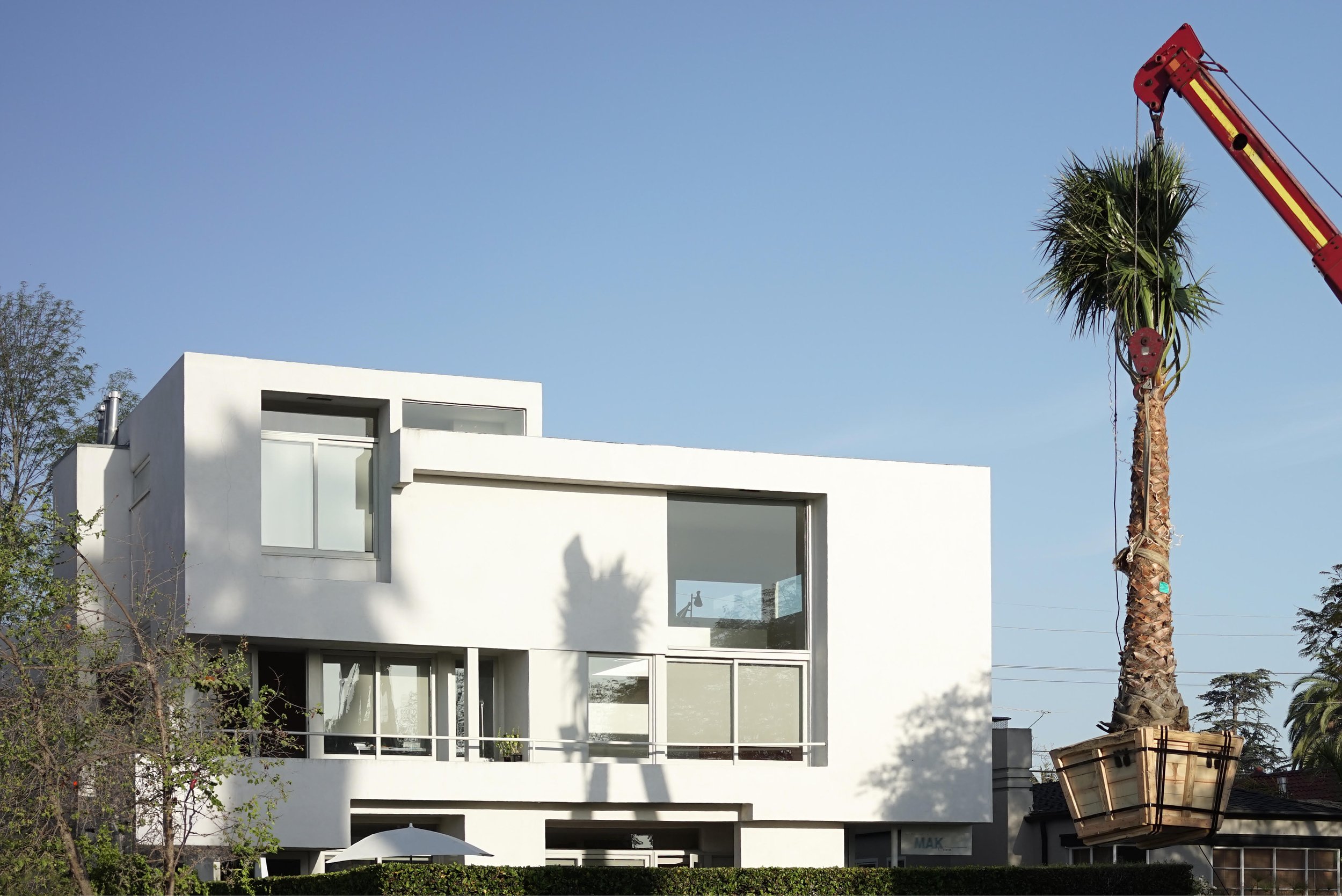
and yet you grow
Image: Courtesy of Christian Kosmas Mayer
The MAK Center for Art and Architecture is pleased to present the 22nd iteration of Garage Exchange Vienna—Los Angeles: and yet you grow featuring work by Vienna-based artist Christian Kosmas Mayer and Los Angeles-based artist Gala Porras-Kim at the Mackey Apartments Garage Top Gallery.
There is something growing in the gallery.
Nine years ago, Christian Kosmas Mayer planted a palm tree in the courtyard of the Mackey Apartments as part of MAK Center’s Artists and Architects-in-Residence Program. The residency ended and moved on to the subsequent groups of residents, but the palm tree remained, under the care of the institution, where it remains today.
In this exhibition, Christian Kosmas Mayer, joined by Los Angeles-based artist Gala Porras-Kim, revisits this living sculpture for an in-depth exploration of the functions and roles of the art institution. Both Mayer and Porras-Kim utilize the exhibition space as a site to foster discourse and critique how art institutions exercise forms of care within collecting practices. The MAK Center is a unique context as it is a non-collecting exhibition space, but it preserves and cares for three R. M. Schindler designed properties in Los Angeles. In this sense, the exhibition spaces are the collection.
This unique relationship between exhibition space and care practice forms the basis of and yet you grow. Porras-Kim's Forecasting Signal is a site-activated sculpture that extracts ambient water from the gallery environment and filters it through a hanging burlap sheet saturated with graphite, extended from the ceiling. As the water accumulates, it drips through the material onto a panel where it makes an image. This process occurs repeatedly through the duration of the exhibition, and turns the exhibition space itself into what could be considered a process-based drawing.
In dialogue with Forecasting Signal is Out of an instance of expiration comes a perennial showing, which also utilizes the environmental conditions of the space, introducing spores from the British Museum storage onto muslin fabric, encased within an acrylic shell. Over the course of the exhibition, a mold grows from these spores and becomes increasingly visible. While the spores originate from the British Museum, an institution with a long and fraught history of collecting practices, the mold grows in the exhibition at the MAK Center’s Mackey Apartment Garage Top Gallery, raising questions about the interconnectedness of art institutions.
Along with the palm tree, Mayer brings another tree into this exhibition, a sapling he grew in 2016 from the acorn of a majestic oak tree that lives in the yard of a small family house in Los Angeles’s Koreatown. This oak, one of the renowned 'Olympic Oaks' presented to all gold medal winners at the 1936 Olympic Games in Berlin, was planted by African American high jump champion Cornelius Johnson upon his return home. Over time, the historical significance of this tree was lost until Mayer uncovered this hidden history through his research.
Over the course of two years, Mayer worked in collaboration with the MAK Center and the California African American Museum for the preservation of this tree, resulting in its designation as a Historic Cultural Monument by the City of Los Angeles in 2022. However, despite this achievement, the destiny of the Olympic oak remains uncertain as the tree has declined in health due to neglect from a new property owner. Now, the young potted oak included in this exhibition, may soon be the solitary living ancestor to this historic legacy.
In and yet you grow, Mayer and Porras-Kim work to reposition the roles of the artist as life givers, and question the traditional role of the curator as collection caretaker safeguarding inanimate objects. Both of these works by Porras-Kim have been exhibited before in other institutions, but each retain a site specificity based on the environmental conditions in which they are shown. Complementing these pieces, Mayer’s site-specific interventions continue his investigation of institutional responsibility and break down the traditional roles of artist practice, curatorship, and architectural intervention. In the context of the palm tree, which now has become a part of the Mackey Apartments, Mayer inverts the Modern critique of museums being places where art dies, and situates the art institution as a site for continued life. In this exhibition, the MAK Center becomes a nursery—birthing, feeding, and parenting artworks with a life of their own.
ABOUT GARAGE EXCHANGE
Garage Exchange Vienna—Los Angeles seeks to foster relationships, conversations and collaborations in the arts between Los Angeles and Austria. In order to expand the cultural exchange at the core of the Artists and Architects-in-Residence program, the Austrian Federal Chancellery and the MAK Center invite Austrian and Vienna-based alumni residents to collaborate with L.A. artists and architects of their choosing at the Garage Top at the Mackey Apartments for the Garage Exchange Vienna-Los Angeles exhibition series.
Artists
Christian kosmas mayer
Christian Kosmas Mayer (b. 1976, Sigmaringen, Germany) lives and works in Vienna, Austria. His work produces and preserves a constellation of narratives about historical remains and representations that are often on the verge of disappearing, or have already been rendered imperceptible. Mayer’s projects, which are the outcome of extensive artistic research and close collaborations with specialists across various disciplines, transform the minor, forgotten, and obsolescent into material artifacts, discursive objects, multi-media installations, and performances. Linking technology to memory and care, his practice explores the methods by which important issues can be approached in conceptually and aesthetically surprising ways: techniques of reversal, of compressing and stretching time, of looking at things from both ends at once.
He has had solo exhibitions at Vienna’s mumok – Museum moderner Kunst Stiftung Ludwig Wien, Austria ; Belvedere Museum, Vienna, Austria; Austrian Cultural Forum New York, USA; MAK Center, Los Angeles, USA; University Gallery of the Custody, Dresden, Germany; Zamek Culture Center, Poznan, Poland; Kunststiftung Baden-Württemberg, Stuttgart, Germany; Austrian Cultural Forum Warsaw, Poland; Galerie Nagel Draxler, Berlin, Germany; Galerie Mezzanin, Geneva, Switzerland and participated in biennales and group exhibitions such as the 26th Bienal de São Paulo, Brazil; Manifesta 7, Rovereto, Italy; Vienna Biennale 2019, Austria; Biennale Gherdëina 2016, Italy; Kunstmuseum Bonn, Germany; Kunstmuseum Stuttgart, Germany; Marta Herford, Germany; Leopoldmuseum, Vienna, Austria; Torrance Art Museum, Los Angeles, USA; ZKM I Center for Art and Media Karlsruhe, Germany; Kunsthalle Wien, Vienna, Austria; Secession, Vienna, Austria; and numerous other venues.
Gala Porras-Kim
Gala Porras-Kim (b. 1984, Bogotá) lives and works in Los Angeles and London. Her work is about the social and political contexts that influence how intangible things, such as sounds, language and history, have been framed through the fields of linguistics, history and conservation. The work considers the way institutions shape inherited codes and forms and conversely, how objects can shape the contexts in which they are placed.
Porras-Kim received an MFA from CalArts and an MA in Latin American Studies from UCLA. She has had solo exhibitions at Museo Universitario de Arte Contemporáneo (MUAC), Mexico City, The Fowler Museum, Los Angeles, Centro Andaluz de Arte Contemporaneo, Seville, Kadist, Amant Foundation, Gasworks, London, and CAMSTL, and upcoming at Leeum Museum of Art and MMCA, Seoul, MCA Denver, and Carnegie Museum of Art. Her work has been included in the Whitney Biennial and Ural Industrial Biennial (2019), and Gwangju and Sao Paulo Biennales (2021) and Liverpool Biennial (2023). She was a Fellow at the Radcliffe Institute for Advanced Study at Harvard University (2019), the artist-in-residence at the Getty Research Institute (2020-22), and currently a fellow at Museo delle Civiltà in Rome.
This exhibition series is made possible by The Austrian Federal Chancellery.
Installation images: Tag Christof.
Exhibition Archive
-
2025
- Feb 27, 2025 – Mar 2, 2025 Final Projects: Group LVI - Realism Feb 27, 2025 – Mar 2, 2025
- Feb 19, 2025 – May 4, 2025 Helmut Lang: What remains behind Feb 19, 2025 – May 4, 2025
-
2024
- Sep 12, 2024 – Dec 8, 2024 Half-Life Sep 12, 2024 – Dec 8, 2024
- Aug 29, 2024 – Sep 2, 2024 Final Projects: Group LV Aug 29, 2024 – Sep 2, 2024
- Jun 22, 2024 – Sep 15, 2024 Entourage Jun 22, 2024 – Sep 15, 2024
- Apr 18, 2024 – Jun 16, 2024 Kathi Hofer and Preserve Bottle Village Committee Apr 18, 2024 – Jun 16, 2024
- Mar 7, 2024 – Mar 10, 2024 Final Projects: Group LIV Mar 7, 2024 – Mar 10, 2024
- Feb 28, 2024 – Apr 7, 2024 VALIE EXPORT: Embodied Feb 28, 2024 – Apr 7, 2024
-
2023
- Nov 11, 2023 – Feb 4, 2024 Print Ready Drawings Nov 11, 2023 – Feb 4, 2024
- Oct 19, 2023 – Jan 7, 2024 and yet you grow Oct 19, 2023 – Jan 7, 2024
- Sep 8, 2023 – Sep 10, 2023 Final Projects: Group LIII Sep 8, 2023 – Sep 10, 2023
- Jun 8, 2023 – Aug 6, 2023 Garage Exchange Vienna—Los Angeles: Plastic, Plastic, Plastic Jun 8, 2023 – Aug 6, 2023
- Apr 1, 2023 – Jul 23, 2023 Seeking Zohn Apr 1, 2023 – Jul 23, 2023
- Mar 10, 2023 – Mar 12, 2023 Final Projects: Group LII Mar 10, 2023 – Mar 12, 2023
- Feb 16, 2023 – Mar 12, 2023 Alex Katz: Sunrise Feb 16, 2023 – Mar 12, 2023
-
2022
- Dec 6, 2022 – Dec 11, 2022 Subject Studies: Reorientations Dec 6, 2022 – Dec 11, 2022
- Nov 10, 2022 – Jan 29, 2023 Garage Exchange: Maruša Sagadin & Jacqueline Kiyomi Gork Nov 10, 2022 – Jan 29, 2023
- Sep 1, 2022 – Sep 4, 2022 Final Projects: Group LI Sep 1, 2022 – Sep 4, 2022
- May 28, 2022 – Sep 25, 2022 Schindler House: 100 Years in the Making May 28, 2022 – Sep 25, 2022
- Apr 14, 2022 – Jul 3, 2022 Garage Exchange: Cosmic Commissioner Apr 14, 2022 – Jul 3, 2022
- Mar 17, 2022 – Mar 20, 2022 Final Projects: Group L Mar 17, 2022 – Mar 20, 2022
- Jan 22, 2022 – Mar 5, 2022 Kristin Posehn: Inverted Dome Jan 22, 2022 – Mar 5, 2022
-
2021
- Nov 21, 2021 – Mar 13, 2022 Florian Hecker - Resynthesizers Nov 21, 2021 – Mar 13, 2022
- Oct 21, 2021 – Jan 9, 2022 Garage Exchange: Aleksandra Domanović and Jen Liu Oct 21, 2021 – Jan 9, 2022
- Oct 16, 2021 – Feb 20, 2022 I hear the ancient music of words and words, yes, that’s it. Oct 16, 2021 – Feb 20, 2022
- Aug 26, 2021 – Oct 3, 2021 Garage Exchange: Antwerp with Benjamin Hirte and Nancy Lupo Aug 26, 2021 – Oct 3, 2021
- May 1, 2021 – Sep 12, 2021 Autonomous Design May 1, 2021 – Sep 12, 2021
-
2020
- Oct 17, 2020 – Mar 28, 2021 DEMO Oct 17, 2020 – Mar 28, 2021
- Sep 26, 2020 AMEND Sep 26, 2020
- Sep 17, 2020 – Sep 20, 2020 wedidntwanttoleave.live Sep 17, 2020 – Sep 20, 2020
- Sep 3, 2020 – Oct 31, 2020 Time is Out of Joint Sep 3, 2020 – Oct 31, 2020
- Mar 5, 2020 – Mar 8, 2020 Final Projects: Group XLIX Mar 5, 2020 – Mar 8, 2020
- Jan 18, 2020 – Feb 29, 2020 Scoring, Building Jan 18, 2020 – Feb 29, 2020
-
2019
- Nov 23, 2019 – Jan 11, 2020 Garage Exchange: Christoph a. Kumpusch of Forward-slash (/) Architektur with Youmna Chlala Nov 23, 2019 – Jan 11, 2020
- Oct 12, 2019 – Feb 16, 2020 Soft Schindler Oct 12, 2019 – Feb 16, 2020
- Sep 5, 2019 – Sep 7, 2019 Final Projects: Group XLVIII Sep 5, 2019 – Sep 7, 2019
- May 2, 2019 – Jun 29, 2019 Garage Exchange: Constanze Schweiger and 69 May 2, 2019 – Jun 29, 2019
- Mar 7, 2019 – Mar 13, 2019 Final Projects: Group XLVII Mar 7, 2019 – Mar 13, 2019
- Feb 9, 2019 – Jun 2, 2019 Shelter or Playground: The House of Dust at the Schindler House Feb 9, 2019 – Jun 2, 2019
-
2018
- Oct 17, 2018 – Dec 8, 2018 Garage Exchange: SPAN (Matias del Campo and Sandra Manninger) and Jay Yan Oct 17, 2018 – Dec 8, 2018
- Sep 16, 2018 – Jan 6, 2019 Edmund de Waal: -one way or other- Sep 16, 2018 – Jan 6, 2019
- Aug 23, 2018 – Aug 31, 2018 Final Projects: Group XLVI Aug 23, 2018 – Aug 31, 2018
- Jun 30, 2018 – Sep 2, 2018 Poetic Structure: Art + Engineering + Architecture Jun 30, 2018 – Sep 2, 2018
- May 11, 2018 – Aug 12, 2018 Fiona Connor: Closed Down Clubs May 11, 2018 – Aug 12, 2018
- Mar 9, 2018 – May 5, 2018 Garage Exchange: The Visitor - Alfredo Barsuglia & Alice Könitz Mar 9, 2018 – May 5, 2018
- Feb 25, 2018 – Mar 4, 2018 Home, Hood, Hill - Final Projects: Group XLV Feb 25, 2018 – Mar 4, 2018
- Feb 3, 2018 – Apr 15, 2018 Public Fiction: The Conscientious Objector Feb 3, 2018 – Apr 15, 2018
- Jan 11, 2018 – Feb 11, 2018 Pin-up: A Designed Tribute to Schindler’s L.A. Jan 11, 2018 – Feb 11, 2018
-
2017
- Nov 9, 2017 – Jan 6, 2018 Garage Exchange: Gravity’s Peacock - Johann Lurf & Brice Bischoff Nov 9, 2017 – Jan 6, 2018
- Sep 9, 2017 – Jan 14, 2018 How to Read El Pato Pascual Sep 9, 2017 – Jan 14, 2018
- Aug 20, 2017 – Sep 4, 2017 Final Projects: Group XLIV Aug 20, 2017 – Sep 4, 2017
- Jun 17, 2017 – Aug 6, 2017 LUSH Jun 17, 2017 – Aug 6, 2017
- May 11, 2017 – Jul 30, 2017 Garage Exchange: Sabine Bitter & Helmut Weber / Edgar Arceneaux May 11, 2017 – Jul 30, 2017
- Mar 23, 2017 – Apr 23, 2017 You may add or subtract from the work: On the work of Christopher D’Arcangelo and Michael Asher Mar 23, 2017 – Apr 23, 2017
- Mar 9, 2017 – Jun 4, 2017 Mandla Reuter: Wasser Mar 9, 2017 – Jun 4, 2017
- Feb 17, 2017 – Feb 26, 2017 Final Projects: Group XLIII Feb 17, 2017 – Feb 26, 2017
-
2016
- Nov 4, 2016 – Feb 4, 2017 Garage Exchange: Jun Yang / Bruce Yonemoto Nov 4, 2016 – Feb 4, 2017
- Oct 20, 2016 – Jan 8, 2017 The Stephanie Taylor Kong Boos Oct 20, 2016 – Jan 8, 2017
- Sep 10, 2016 – Sep 11, 2016 Final Projects: Group XLII Sep 10, 2016 – Sep 11, 2016
- May 25, 2016 – Aug 14, 2016 Routine Pleasures May 25, 2016 – Aug 14, 2016
- Apr 21, 2016 – Jun 25, 2016 Garage Exchange: Past Future Housing - Morgan Fisher / Karina Nimmerfall Apr 21, 2016 – Jun 25, 2016
- Apr 9, 2016 – May 8, 2016 House Housing: An Untimely History of Architecture and Real Estate in Thirty-one Episodes Apr 9, 2016 – May 8, 2016
- Mar 11, 2016 – Mar 12, 2016 Final Projects: Group XLI - We Only Went to NASA Together Mar 11, 2016 – Mar 12, 2016
- Jan 28, 2016 – Mar 27, 2016 Erwin Wurm: One Minute Sculptures Jan 28, 2016 – Mar 27, 2016
-
2015
- Nov 13, 2015 – Mar 5, 2016 Garage Exchange: Spomenici revolucije - Marko Lulić / Sam Durant Nov 13, 2015 – Mar 5, 2016
- Sep 10, 2015 – Dec 6, 2015 R.M. Schindler: The Prequel Sep 10, 2015 – Dec 6, 2015
- Sep 5, 2015 – Feb 6, 2016 Final Projects: Group XL Sep 5, 2015 – Feb 6, 2016
- Jun 10, 2015 – Aug 16, 2015 The New Creativity: Man and Machines Jun 10, 2015 – Aug 16, 2015
- May 1, 2015 – Aug 29, 2015 Garage Exchange: Fictitious Tales About the History of Earth May 1, 2015 – Aug 29, 2015
- Apr 17, 2015 – May 17, 2015 A Vast Furniture: Installation by Carmen Argote Apr 17, 2015 – May 17, 2015
- Apr 6, 2015 – Aug 28, 2015 Los Bar Apr 6, 2015 – Aug 28, 2015
- Mar 13, 2015 – Mar 15, 2015 Final Projects: Group XXXIX Mar 13, 2015 – Mar 15, 2015
- Jan 21, 2015 – Mar 29, 2015 Renée Green: Begin Again, Begin Again Jan 21, 2015 – Mar 29, 2015
-
2014
- Oct 25, 2014 – Jan 4, 2015 Groundswell: Guerilla Architecture In Response To The Great East Japan Earthquake Oct 25, 2014 – Jan 4, 2015
- Oct 3, 2014 – Oct 29, 2014 The Entire Situation: An Installation by Erin Besler Oct 3, 2014 – Oct 29, 2014
- Sep 4, 2014 – Sep 7, 2014 Final Projects: Group XXXVIII Sep 4, 2014 – Sep 7, 2014
- Jun 18, 2014 – Sep 7, 2014 Tony Greene: Room of Advances Jun 18, 2014 – Sep 7, 2014
- Apr 18, 2014 – Aug 16, 2014 Garage Exchange: The Eden’s Edge Project Apr 18, 2014 – Aug 16, 2014
- Apr 9, 2014 – Jun 1, 2014 AV Andrea Fraser Vanessa Place Apr 9, 2014 – Jun 1, 2014
- Mar 14, 2014 – Mar 16, 2014 Final Projects Group XXXVII - jaywalk Mar 14, 2014 – Mar 16, 2014
- Jan 29, 2014 – Mar 9, 2014 City in a City: A Decade of Urban Thinking by Steven Holl Architects Jan 29, 2014 – Mar 9, 2014
-
2013
- Nov 7, 2013 – Mar 1, 2014 Garage Exchange: Constanze Ruhm & Christine Lang and First Office Nov 7, 2013 – Mar 1, 2014
- Oct 13, 2013 – Jan 5, 2014 A Little Joy of a Bungalow Oct 13, 2013 – Jan 5, 2014
- Sep 13, 2013 – Sep 15, 2013 Final Projects: Group XXXVI - SMILE Sep 13, 2013 – Sep 15, 2013
- May 8, 2013 – Aug 4, 2013 Everything Loose Will Land May 8, 2013 – Aug 4, 2013
- Apr 19, 2013 – Aug 10, 2013 Garage Exchange Smooth Matter Apr 19, 2013 – Aug 10, 2013
- Mar 8, 2013 – Mar 10, 2013 Final Projects: Group XXXV Mar 8, 2013 – Mar 10, 2013
- Feb 14, 2013 – Apr 7, 2013 Plan your visit Feb 14, 2013 – Apr 7, 2013
-
2012
- Nov 16, 2012 – Mar 2, 2013 Garage Exchange: Double Crossings - Hans Schabus and the Center for Land Use Interpretation Nov 16, 2012 – Mar 2, 2013
- Sep 6, 2012 – Sep 9, 2012 Final Projects Group XXXIV - Material and Culture Sep 6, 2012 – Sep 9, 2012
- Jun 8, 2012 – Sep 22, 2012 Garage Exchange: Bend a Bow Jun 8, 2012 – Sep 22, 2012
- May 15, 2012 – Aug 12, 2012 Out Spoken: Lectures from the Sci-Arc Media Archive May 15, 2012 – Aug 12, 2012
- Mar 9, 2012 – Mar 11, 2012 Final Projects: Group XXXIII Mar 9, 2012 – Mar 11, 2012
-
2011
- Sep 28, 2011 – Jan 29, 2012 Sympathetic Seeing: Esther McCoy and the Heart of American Modernist Architecture and Design Sep 28, 2011 – Jan 29, 2012
- Sep 8, 2011 – Sep 11, 2011 Final Projects: Group XXXII Sep 8, 2011 – Sep 11, 2011
- Jun 17, 2011 – Aug 6, 2011 Light Pavilion Jun 17, 2011 – Aug 6, 2011
- Mar 10, 2011 – Mar 13, 2011 Final Projects: Group XXXI Mar 10, 2011 – Mar 13, 2011
- Mar 5, 2011 – Apr 24, 2011 Schinder Lab, Round One Mar 5, 2011 – Apr 24, 2011
- Jan 5, 2011 – Feb 11, 2011 91 92 93 Jan 5, 2011 – Feb 11, 2011
-
2010
- Sep 16, 2010 – Oct 16, 2010 Brandon Lattu: Reciprocity of Light Sep 16, 2010 – Oct 16, 2010
- Sep 10, 2010 – Sep 12, 2010 Final Projects: Group XXX Sep 10, 2010 – Sep 12, 2010
- Jun 25, 2010 – Sep 29, 2010 Fractional Systems.Garage Project II Jun 25, 2010 – Sep 29, 2010
- Mar 12, 2010 – Mar 16, 2010 Final Projects: Group XXIX Mar 12, 2010 – Mar 16, 2010
- Feb 8, 2010 – Jun 30, 2010 How Many Billboards? Art in Stead Feb 8, 2010 – Jun 30, 2010
-
2009
- Nov 3, 2009 – Jan 31, 2010 Otto Neurath. Gypsy Urbanism Nov 3, 2009 – Jan 31, 2010
- Sep 4, 2009 – Sep 9, 2009 Final Projects: Group XXVIII Sep 4, 2009 – Sep 9, 2009
- May 27, 2009 – Aug 23, 2009 The Isle May 27, 2009 – Aug 23, 2009
- Mar 13, 2009 – Mar 15, 2009 Final Projects: Group XXVII Mar 13, 2009 – Mar 15, 2009
- Jan 15, 2009 – Mar 9, 2009 Locus Remix. Three Contemporary Positions: Dorit Margreiter Jan 15, 2009 – Mar 9, 2009
-
2008
- Nov 5, 2008 – Jan 4, 2009 Locus Remix. Three Contemporary Positions: Ismail Farouk - “Cancelled Without Prejudice” Nov 5, 2008 – Jan 4, 2009
- Sep 4, 2008 – Oct 26, 2008 Locus Remix. Three Contemporary Positions: Katie Grinnan - “Polaris” Sep 4, 2008 – Oct 26, 2008
- Aug 20, 2008 – Aug 24, 2008 Final Projects: Group XXVI - ReadyFasterBurnsLonger Aug 20, 2008 – Aug 24, 2008
- Jun 20, 2008 Hinterland Jun 20, 2008
- Mar 9, 2008 – Mar 16, 2008 Hana Reichman Gallery Mar 9, 2008 – Mar 16, 2008
- Mar 6, 2008 – Mar 9, 2008 Final Projects: Group XXV - Ah CA va bien Mar 6, 2008 – Mar 9, 2008
-
2007
- Nov 10, 2007 – Feb 24, 2008 Victor Burgin: The Little House Nov 10, 2007 – Feb 24, 2008
- Sep 6, 2007 – Sep 9, 2007 Final Projects: Group XXIV - The Mystery of Life Sep 6, 2007 – Sep 9, 2007
- May 17, 2007 – Aug 26, 2007 Arnulf Rainer: Hyper-Graphics May 17, 2007 – Aug 26, 2007
- Mar 8, 2007 – Mar 11, 2007 Final Projects: Group XXIII - Exquisite Corpse Mar 8, 2007 – Mar 11, 2007
-
2006
- Oct 29, 2006 – Feb 25, 2007 The Gen[H]ome Project Oct 29, 2006 – Feb 25, 2007
- Sep 6, 2006 – Sep 10, 2006 Final Projects: Group XXII - CENTER Sep 6, 2006 – Sep 10, 2006
- Mar 10, 2006 – Mar 12, 2006 Final Projects: Group XXI - Love After the Cold War in an Open House of a (Re) Constructed Babylon by a Popular Mechanic Mar 10, 2006 – Mar 12, 2006
-
2005
- Sep 23, 2005 – Sep 25, 2005 Final Projects: Group XX - ‘glass, concrete and stone, it’s just a house not a home’ Sep 23, 2005 – Sep 25, 2005
- Jul 15, 2005 – Oct 23, 2005 Isaac Julien: True North Jul 15, 2005 – Oct 23, 2005
- May 13, 2005 Final Projects: Group XIX - Friday the 13th May 13, 2005
- Mar 31, 2005 – Jun 26, 2005 Günther Domenig: Structures That Fit My Nature Mar 31, 2005 – Jun 26, 2005
- Jan 7, 2005 – Feb 20, 2005 Jesse Webber: Hitch Jan 7, 2005 – Feb 20, 2005
- Jan 7, 2005 – Feb 20, 2005 Amir Zaki: Spring Through Winter Jan 7, 2005 – Feb 20, 2005
-
2004
- Sep 7, 2004 – Sep 9, 2004 Final Projects: Group XVIII - Mandatory Sep 7, 2004 – Sep 9, 2004
- May 14, 2004 – Aug 29, 2004 Yves Klein: Air Architecture May 14, 2004 – Aug 29, 2004
- Mar 12, 2004 – Mar 14, 2004 Final Projects: Group XVII - It’s Time to Stay Home and Get Some Audience Mar 12, 2004 – Mar 14, 2004
- Feb 6, 2004 – Mar 17, 2004 3 Fireplaces and 2 Bathtubs Feb 6, 2004 – Mar 17, 2004
-
2003
- Aug 15, 2003 – Sep 7, 2003 Final Projects: Group XVI - Absolute L.A. International Aug 15, 2003 – Sep 7, 2003
- Aug 6, 2003 – Dec 7, 2003 Schindler’s Paradise: Architectural Resistance Aug 6, 2003 – Dec 7, 2003
- Mar 21, 2003 – Mar 23, 2003 Final Projects: Group XV Mar 21, 2003 – Mar 23, 2003
- Feb 16, 2003 – Feb 23, 2003 Plugged and Haunted: Garage Projects at the Mackey Apartments Feb 16, 2003 – Feb 23, 2003
- Jan 29, 2003 – Jul 27, 2003 TRESPASSING: Houses x Artists Jan 29, 2003 – Jul 27, 2003
-
2002
- Dec 15, 2002 – Dec 22, 2002 Home Scenes: 8 Days of Revision Dec 15, 2002 – Dec 22, 2002
- Oct 11, 2002 – Jan 15, 2003 Desert cloud <transformer3> Oct 11, 2002 – Jan 15, 2003
- Sep 18, 2002 – Sep 29, 2002 Final Projects: Group XIV Sep 18, 2002 – Sep 29, 2002
- May 9, 2002 – Sep 8, 2002 Gerald Zuggman: Blue Universe, Architectural Manifestos by COOP HIMMELB(L)AU May 9, 2002 – Sep 8, 2002
- Feb 1, 2002 – Feb 28, 2002 Final Projects: Group XIII Feb 1, 2002 – Feb 28, 2002
- Jan 23, 2002 – Apr 14, 2002 MARKINGS: Constructing Form through Drawing Jan 23, 2002 – Apr 14, 2002
-
2001
- Sep 20, 2001 – Oct 28, 2001 Final Projects: Group XII - 20/35 Vision Sep 20, 2001 – Oct 28, 2001
- Jul 20, 2001 – Sep 2, 2001 In Between: Art and Architecture - Part 3 Jul 20, 2001 – Sep 2, 2001
- Mar 17, 2001 – Mar 18, 2001 Final Projects: Group XI - RAIN Mar 17, 2001 – Mar 18, 2001
- Mar 9, 2001 – Sep 2, 2001 In Between: Art and Architecture - Part 2 Mar 9, 2001 – Sep 2, 2001
- Feb 16, 2001 – Feb 18, 2001 In Between: Art and Architecture - Part 1 Feb 16, 2001 – Feb 18, 2001
-
2000
- Dec 6, 2000 – Feb 25, 2001 Frederick J. Kiesler: Endless Space Dec 6, 2000 – Feb 25, 2001
- Oct 29, 2000 – Dec 17, 2000 heaven’s gift Oct 29, 2000 – Dec 17, 2000
- Sep 26, 2000 – Oct 15, 2000 Final Projects: Group X - Oxygen: Flipping through Frederick Kiesler Sep 26, 2000 – Oct 15, 2000
- Jun 2, 2000 – Sep 17, 2000 American Pictures 1961 - 1967: Photographs by Dennis Hopper Jun 2, 2000 – Sep 17, 2000
- Apr 14, 2000 – Apr 16, 2000 Final Projects: Group IX - If I was in L.A. Apr 14, 2000 – Apr 16, 2000
- Jan 26, 2000 – Feb 20, 2000 Location Proposal #2 Jan 26, 2000 – Feb 20, 2000
-
1999
- Oct 13, 1999 – Jan 16, 2000 Numbers Oct 13, 1999 – Jan 16, 2000
- Sep 22, 1999 Final Projects: Group VIII - Some Things to Be Seen or Taking Place not Necessarily Related to Each Other Sep 22, 1999
- Jul 22, 1999 – Sep 26, 1999 LIFE/BOAT Jul 22, 1999 – Sep 26, 1999
- Jun 2, 1999 – Jul 11, 1999 Micro Space/Global Time: An Architectural Manifesto Jun 2, 1999 – Jul 11, 1999
- Mar 19, 1999 – Mar 21, 1999 Final Projects: Group VII Mar 19, 1999 – Mar 21, 1999
- Mar 10, 1999 – May 30, 1999 Architecture and Revolution: Escuelas Nacionales de Arte en La Habana Mar 10, 1999 – May 30, 1999
-
1998
- Oct 28, 1998 – Jan 17, 1999 The best animals are the flat animals Oct 28, 1998 – Jan 17, 1999
- Sep 19, 1998 – Sep 26, 1998 Final Projects: Group VI Sep 19, 1998 – Sep 26, 1998
- Jul 9, 1998 Martin Kippenberger, The Last Stop West Jul 9, 1998
- Mar 13, 1998 – Mar 29, 1998 Final Projects: Group V - Befejezett Munka Mar 13, 1998 – Mar 29, 1998
- Feb 3, 1998 – Feb 28, 1998 Twelve Projects by R.M. Schindler Feb 3, 1998 – Feb 28, 1998
-
1997
- Nov 17, 1997 – Jan 18, 1998 Anarchitecture: Works by Gordon Matta-Clark Nov 17, 1997 – Jan 18, 1998
- Sep 13, 1997 – Sep 28, 1997 Final Projects: Group IV - Ich bin ein L.A. Sep 13, 1997 – Sep 28, 1997
- Jul 18, 1997 L.A.NDING Jul 18, 1997
- Mar 20, 1997 – Mar 22, 1997 Final Projects: Group III - Open House / Open Studio Mar 20, 1997 – Mar 22, 1997
- Mar 19, 1997 – Aug 31, 1997 Silent & Violent: Selected Artists Mar 19, 1997 – Aug 31, 1997
- Feb 1, 1997 – Mar 22, 1997 room of displacement/loneliness Feb 1, 1997 – Mar 22, 1997
-
1996
- Sep 17, 1996 – Sep 30, 1996 Final Projects: Group II Sep 17, 1996 – Sep 30, 1996
- Apr 13, 1996 – Aug 27, 1996 The Havana Project, Architecture Again Apr 13, 1996 – Aug 27, 1996
- Apr 13, 1996 – Aug 14, 1996 The Garage Project Apr 13, 1996 – Aug 14, 1996
- Mar 18, 1996 – Mar 24, 1996 Final Projects: Group I - Art Protects You Mar 18, 1996 – Mar 24, 1996


















